How to write a school report
Imagine the end of the academic year is upon us, and amidst the anticipation of summer, there’s a significant task at hand for teachers: the crafting of school reports. Far more than mere paperwork, these reports are a bridge between school and home, offering insights into a student’s progress, achievements, and areas for growth. They can influence a student’s self-esteem, motivate them towards future accomplishments, and foster a stronger partnership with parents—all pivotal components of a student’s academic journey.
Writing a school report, therefore, is much more than summarizing a year’s worth of grades and comments. It’s about capturing the essence of a student’s learning journey, highlighting their successes, and gently guiding them towards their next steps in education. In some ways, it’s an art form in itself, requiring a delicate balance between honesty and encouragement, precision and brevity.
This guide is designed to walk you through the nuances of creating effective and meaningful school reports. Whether you’re a seasoned educator or new to the teaching profession, the following insights will help you navigate the complexities of report writing, making it a less daunting and more rewarding part of your teaching role. Let’s embark on this journey together, transforming the task of report writing from a cumbersome obligation into an opportunity to inspire and engage with the young minds entrusted to our care.

What to report on
Navigating the vast landscape of a student’s academic year can feel overwhelming when it comes time to distill everything into a concise school report. However, focusing on key areas can not only streamline the process but also ensure that the report is informative, balanced, and tailored to the individual student. Here are the essential components to consider when determining what to include in your school reports:
1. Academic Achievements
Detail the student’s accomplishments across subjects, highlighting specific projects or assignments where they excelled. Aim to include examples that showcase their skills, understanding, and progress. This not only provides evidence of their achievements but also helps in painting a comprehensive picture of their academic journey.
2. Learning and Personal Development
Beyond academic performance, consider aspects of the student’s personal growth . This might include improvements in problem-solving, critical thinking, creativity, or resilience. Reflecting on how a student has developed personally and socially throughout the year offers a more holistic view of their progress.
3. Challenges and Areas for Improvement
Identify areas where the student faced challenges or could benefit from further development. Framing these within the context of their overall growth journey encourages a positive outlook towards overcoming these hurdles.
4. Behavior and Participation
Comment on the student’s behavior in class, their participation in discussions, group work , and extracurricular activities. This gives insight into their social skills , teamwork capabilities, and engagement with the school community.
5. Goals and Future Directions
Outline objectives for the student’s future learning, suggesting areas where they can aim to improve or subjects they might wish to explore more deeply. Setting goals helps motivate students and provides a clear direction for their continued education.
Tips for Effective Reporting:
- Use Positive Language: Frame challenges as opportunities for growth, using language that encourages and motivates.
- Be Specific and Evidence-Based: General comments are less impactful than specific examples that highlight a student’s achievements or areas for improvement.
- Personalize Your Comments: Tailor your reports to reflect the individuality of each student, making them feel seen and understood.
By focusing on these components, your school reports can become powerful tools for communication and motivation. They not only inform parents and guardians about their child’s progress but also play a crucial role in shaping the student’s self-perception and approach to learning.
Creating Focused and Concise School Reports
The art of writing effective school reports lies in the ability to convey meaningful information in a clear and succinct manner. With the limited space and the importance of maintaining the reader’s attention, focusing your reports ensures that they are impactful and valuable. Here’s how you can achieve this:
Keep It Relevant
Focus on the individual.
Every student is unique, with their own strengths, challenges, and journey through the academic year. Tailor your reports to reflect these individual differences, ensuring that your comments are directly relevant to the student in question. Avoid generic statements that could apply to anyone; instead, provide specific insights into the student’s personal academic and developmental journey.
Prioritize Key Points
Identify the most significant achievements, challenges, and areas for improvement for each student. While it might be tempting to cover everything, prioritizing the most impactful information will make your report more readable and meaningful. Ask yourself, “What are the key takeaways for this student’s year?”
Be Brief, But Comprehensive
Concise language.
Use clear, concise language to express your thoughts. Avoid jargon and overly complex sentences that might confuse readers. Remember, the goal is to communicate effectively with parents and students, not to impress with vocabulary.
Bullet Points and Highlights
When appropriate, use bullet points to break down information into digestible pieces. Highlighting major achievements or areas for growth can make your report easier to read and more accessible for parents and students alike.
Gather and Organize Your Information
Systematic note-taking.
Maintain organized records of student progress , achievements, and notable incidents throughout the year. This practice will save you time when writing reports and ensure that you don’t overlook important details.
Collaborate for a Holistic View
Consult with colleagues who have also taught or interacted with the student. This collaboration can provide a more rounded view of the student’s abilities and behaviors, enabling you to write a more comprehensive report.
Writing Tips for Clarity and Impact
- Start Strong: Begin each section of your report with the most important information to ensure key points are communicated effectively.
- Use Active Voice: Active voice makes your writing clearer and more direct, which is particularly effective in short reports.
- Examples and Evidence: Where possible, back up your statements with examples or brief anecdotes that illustrate the student’s progress or areas for improvement.
By adhering to these principles, you’ll be able to write school reports that are not only focused and concise but also deeply informative and engaging. This approach not only respects the time and attention of the report’s readers but also provides students and parents with clear, actionable insights into the student’s academic journey and personal growth.
Balancing Encouragement and Constructive Feedback in School Reports
Crafting a school report that both acknowledges accomplishments and addresses areas for improvement requires a thoughtful approach. Here’s how to strike that balance, ensuring your reports are not only informative but also inspiring and motivational.
Writing Encouragingly
Celebrate Achievements: Highlight the student’s successes, no matter how small. This recognition boosts confidence and reinforces positive behaviors and efforts. Use phrases like “demonstrated strong ability in” or “showed remarkable improvement in” to spotlight achievements.
Focus on Effort and Progress: Emphasize the student’s effort, resilience, and progress over the year. This approach shifts the focus from innate ability to growth and improvement, which is especially encouraging for students facing challenges.
Use Positive Language: Frame feedback in a positive light. For instance, instead of saying “failed to meet expectations,” you might say “has room to grow in.” This positive framing helps maintain a student’s motivation and self-esteem.
Personalize Praise: Make your commendations as specific as possible to the individual. This not only makes the praise more meaningful but also shows the student that you see and appreciate their unique efforts and achievements.
Delivering Negative Feedback
Be Specific and Objective: When addressing areas for improvement, be clear about the specific behaviors or outcomes that need attention. Use objective terms and avoid personal criticism to keep the feedback constructive .
Offer Solutions and Support: Alongside pointing out areas for growth, provide suggestions for how the student can improve. Offer resources, strategies, or additional support where possible. This shows your commitment to their development and turns challenges into opportunities for learning.
Balance with Positives: Use the “sandwich” method by framing negative feedback between positive comments. This technique helps soften the impact of criticisms and keeps the overall tone of the report encouraging.
Encourage a Growth Mindset: Remind students that abilities and intelligence can be developed with effort, strategies, and help from others. Encourage them to view challenges as opportunities to learn and grow, rather than insurmountable obstacles.
Practical Examples:
- Instead of: “John struggles with math and is below grade level.”
- Try: “John has shown a keen interest in understanding math concepts and, with continued support and practice, will develop stronger skills in this area.”
- Instead of: “Sarah lacks participation in class discussions.”
- Try: “Sarah has valuable insights to share and could enhance her learning experience by participating more in class discussions. Encouraging her to express her thoughts will boost her confidence and contribute to our classroom community.”
By applying these strategies, you can craft school reports that not only provide a realistic overview of the student’s performance but also inspire and motivate them towards future successes. Such reports can strengthen the student-teacher relationship, build trust with parents, and most importantly, empower students to embrace challenges and celebrate their progress.
Conclusion: Mastering the Craft of School Report Writing in Secondary Education
The process of school report writing, especially in the context of secondary education , embodies more than just an administrative or assessment task; it’s an art form that bridges the gap between a student’s efforts and their achievements. Despite being time-consuming, the creation of year reports is a fundamental exercise in providing detailed information about a student’s progress, both for the educators who compile them and the families who receive them.
The Value of School Reports in Secondary Schools
In many schools, the annual ritual of writing reports is a critical reflection of a student’s journey through complex secondary school subjects and personal development. These reports offer a unique opportunity to convey the outcome of various assessment tasks and the student’s own work over the year in a cohesive narrative that highlights growth, challenges, and future directions.
Navigating the Challenges
Acknowledging that school report writing can be a time-consuming endeavor is crucial. The meticulous nature of compiling detailed information for each student requires a significant investment of time and effort. However, this investment is what makes these reports invaluable. They are not just a record of achievements but a tool for feedback and forward planning.
Inspiring Future Endeavors
The ultimate goal of writing reports in secondary education is not merely to assess past performance but to inspire students for future learning. These documents play a pivotal role in motivating students, guiding them to recognize their strengths and areas for improvement. By providing a balanced view that celebrates achievements while also identifying challenges, educators can encourage students to engage deeply with their own work and learning journey.
Strengthening Educational Partnerships
Effective school report writing fosters a stronger connection among teachers, students, and parents. By sharing detailed information about a student’s progress, educators open the door for meaningful conversations about how to support the student’s education. These reports become a cornerstone for building trust and collaboration within the school community.
Embracing the Process
While the task of writing year reports for many schools may seem daunting due to its detailed and time-consuming nature, embracing this responsibility with a positive mindset can transform it into a rewarding aspect of teaching. Every report is an opportunity to reflect on the impact of your teaching and to contribute significantly to a student’s educational journey in secondary school .
Closing Reflection
As we refine our approach to school report writing, let us view each report as a canvas on which the story of a student’s year is painted. Let your reports be detailed, insightful, and inspiring, serving not just as an assessment tool but as a beacon guiding students toward their future successes. In the intricate tapestry of secondary education, your reports are threads that connect the past, present, and future, weaving together the rich narrative of each student’s academic and personal growth.
About The Author
Impact teachers, impact teachers – an introduction.
Impact Teachers is a teacher recruitment company founded with a vision of making a local, national and global impact on education.
Read More »
Rob Grillo’s BEN Experience
Rob Grillo - Twelve months ago was nervously making his final plans before departure to India for his first trip with Impact Teachers to Bihar.
Impact’s Survival Guide: 10 Things NQTs Need to Know
There are countless myths about the big bad world of education and we at Impact are here to hook you up with fantastic teaching jobs…
2 thoughts on “How to write a school report”
THANK YOU FOR YOUR SOURCE. I GET MUCH INFORMATION FROM THIS.
You’re welcome. I’m happy we can support you. That’s what we like to do.
Leave a Comment Cancel Reply
Your email address will not be published. Required fields are marked *
Save my name, email, and website in this browser for the next time I comment.
- Search the entire site Search
Home Training & Certifications Investigation Skills and Report Writing for Higher Education
Investigation Skills and Report Writing for Higher Education
Build on the Concepts from the Higher Education Investigation Foundations Course
Register Now
Title IX Fundamentals for Higher Education Investigation Foundations for Higher Education
Compose Clear, Cogent, and Compliant Investigation Reports
Investigation Skills and Report Writing for Higher Education focuses on improving interviewing techniques and post-interview tasks such as credibility assessment, information synthesis, and clear report writing.
Participants will review a sample investigation report to guide their understanding of report writing mechanics, format, and structure. Additionally, registrants will engage in various interactive learning activities to practice their skills and receive feedback from ATIXA’s experts.
Topics Covered:
- Overview of the Investigation Process
- Trauma and Investigations
- Investigation Strategy
- Notetaking and Recordkeeping
- Parsing the Policy
- Collecting and Managing Evidence
- Purpose of the Investigation Report
- Writing Mechanics
- Writing Clarity
- Absent Information
- Investigation Report Sections
Key Takeaway
Increase your proficiency at identifying bias, prejudice, and conflicts of interest, protect participant privacy, and eliminate problematic language in investigation reports to ensure compliance and professionalism.
After completing this training, participants will be able to:
- Develop interview questions designed to elicit information that is relevant to a specific allegation
- Explain how to apply the five factors to consider when assessing credibility
- Determine the information that should be included in each section of an investigation report
- Identify problematic language in investigation reports and suggest remedies
- Integrate different sources of evidence into an investigation report in a clear manner
- Use best practices for protecting participant privacy through redaction, etc
- Address the absence of specific evidence in an investigation report
- Provide examples of how bias, prejudice, and/or conflicts of interest may impact an investigation
Who Should Attend?
- Title IX Coordinators
- Deputy Title IX Coordinators
- Title IX or Civil Rights Investigators
- Decision-makers
- Appeal Decision-makers
- Human Resources Professionals
- Student Conduct Professionals
- Legal Counsel
- Law Enforcement/Campus Safety/School Resource Officers
- Compliance and Risk Management Professionals (Title VI, Title VII, Title IX, ADA/Section 504, AA, EEO, Clery)
- Hearing/Process Advisors
- Intake/Case Coordinators
- Attorneys Serving as Advisors
- Diversity, Equity, and Inclusion Professionals
In-Person Training
Live, In-Person Training
- $1,690 Member
- $1,790 Non-Member
Hide Details & Schedule
- June 6 - 7: 8:30am - 4:30pm MDT Embassy Suites by Hilton Denver Downtown Convention Center Register
*Effective July 1st, ATIXA training & event pricing will increase by approximately 5%. We invite you to register early to lock in our current pricing.
*You must attend all dates in your session to receive credit for attendance.
Multi registration discounts are provided on a sliding scale based on the applicable registrations on the same order. Individualized discounts are as follows:
- 1st registration – full price of registration
- 2-4 registrations – 15% discount per line item
- 5+ registrations – 25% discounted per line item
Please create your order, click the 'Pay Later' option upon checkout, and reach out to [email protected] for the discounts to be applied.
If you are interested in consulting options, please contact [email protected] for personalized assistance.
Virtual Instructor-Led
Live, Interactive Online Training
- July 15 - 16: 11:00am - 6:00pm ET Register
What does my Registration Fee Include?
To obtain certification from ATIXA, you will need to sign-in to your Event Lobby each day of training and attend the whole event. It is our expectation that you are present for the entire duration of your training course. Certification will only be provided once ATIXA has verified attendance through the Event Lobby.
Please allow 7-10 days following the completion of the course and then log in on our website and visit the My ATIXA page to access the Continuing Certification Credit (CCC) program system. Please follow the instructions on the webpage to obtain your certification. Our CCC program allows those certified by ATIXA to track, maintain, and extend their professional development through our programs.
PLEASE NOTE: Certification refers to attendance at a qualifying event; TNG cannot speak to individual attendees’ knowledge, expertise, or command of the material.
What does my Certification mean?
- Attendance for each day of training or access to eTraining course for three months
- An extensive course-specific selection of articles, customizable forms and templates, case studies, videos, and more
- Instructional slides or transcript for eTraining
- Access to ATIXA content experts
- Ability to interact with faculty and attendees via course discussion and activities
- Certification upon corresponding course completion
Ready to talk about Title IX?
Reach out to learn more about how ATIXA’s solutions can help.
Reset your password
As part of our contined effort to improve our portal and user experience, we are currently requiring some users to reset their passwords.
Please click the button below to recieve an email with additional instructions for resetting your password.
Become a member

how to write an academic report: Examples and tips

Writing a report should be concise and to the point. It should also be relevant to the topic. Make sure to check your work with someone and read it aloud. Proofreading is also important because computer programs cannot catch every mistake. You may even want to wait a day before you read it to make sure that it is error-free. Keep in mind that an academic report differs from a business or technical report.
Avoiding the present tense
While the present tense is commonly used in academic writing, it isn’t always necessary. When anyone tells you about writing how to write an academic report , you can switch the tense within the same sentence or paragraph when you shift from general statements to more specific examples based on research. Other times, it’s appropriate to use the present tense when you write about a particular event that has changed over time.
The best time to use either tense is determined by the context in which you’re writing. While both are acceptable, you’ll want to ensure that your reader knows when you made your findings. In most cases, the present tense will mean that you’re writing about the time you did the research, while the past tense can be interpreted in different ways.
Introducing your topic
The introduction is the first section of your paper, and it should capture the reader’s interest and make them want to read the rest of your paper. You can do this by opening with a compelling story, question, or example that shows why your topic is important. The hook should also establish the relevance of your paper in the wider context.
The introduction should also have a thesis statement, which should explain your research paper’s topic and point of view. This statement will guide the organization of your essay. A strong thesis statement is specific, clear, and able to be proved.
Stating your thesis statement
Your thesis statement should be clear and concise. It should be able to persuade others while laying out your strong opinions. It should also contain an argument. For example, you could argue that the government should ban 4×4 pickup trucks. Or, you might argue that the amount of foul language in movies is disproportionate to the amount of it in real life.
A strong thesis statement contradicts a commonly held viewpoint. It is not too complex to explain over the course of the paper. It should also express a single main idea.
Putting together an outline before writing your report
Putting together an outline is a great way to organize your paper. Outline the content that you will cover and how you plan to support your main point. You can use a list format or alpha-numeric format to organize your outline. Regardless of the format, your outline should have a parallel structure and include the same types of words in each section. It is also a good idea to include citations whenever possible.
When you’re writing, outlining will help you get the most out of your writing. It will save you time and effort when writing because you can make full sentences and well-developed essays with an outline.
Avoiding jargon
One of the most important things to remember when writing an academic report is to avoid using jargon. These words are often difficult to understand, and although they are useful shorthand for scientists, they may alienate non-specialist readers. The use of jargon is the most common reason that readers complain about writing, but there are ways to replace these terms with plainer versions.
Jargon is specialized terminology used by a specific group. It can be incredibly difficult to understand if you’re not part of the group. It also tends to make your writing more complicated and shows that you’re trying to show off your knowledge.
How to Write an Academic Report – Examples and Tips
While the present tense is commonly used in academic writing, it isn’t always necessary. When writing an academic report, you can switch the tense within the same sentence or paragraph when you shift from general statements to more specific examples based on research. Other times, it’s appropriate to use the present tense when you write about a particular event that has changed over time.
Owen Ingram is a research-based content writer, who works for Cognizantt, a globally recognised professional SEO service and Research Prospect , a Servizio di redazione di saggi e dissertazioni . Mr Owen Ingram holds a PhD degree in English literature. He loves to express his views on a range of issues including education, technology, and more.
Related Posts

Which are the best report writer that assists me in writing academic report

Reflective report structure: here is the brief guide and help
Leave a comment cancel reply.
Your email address will not be published. Required fields are marked *
Save my name, email, and website in this browser for the next time I comment.
- Directories
Report writing
Report writing is common in a number of disciplines. A report is a specific form of writing, written concisely and clearly and typically organised around identifying and examining issues, events, or findings from a research investigation.
Reports often involve investigating and analysing a problem and coming up with a solution. This means that you need to take a position or provide a solution and you need clear reasons for your solution.
A key, central message is a vital part of the report and will help to make it clear and persuasive.
A report might involve
- an analysis of existing data and literature
- conducting analysis and problem solving
- results of an investigation
Whatever the type of report, they are expected to be well written, clearly structured and expressed in a way that suits the particular audience. Results and analysis should be accurate, clear and objective. Report structures can vary between disciplines and audiences but the structure needs to support the key message.
Reports differ from essays in a number of ways. Consider the following:
Report writing process
It can be helpful to think of writing your report as a process and to break it down into the various tasks that you need to complete.
What goes on when you are writing a report? What are the various tasks you need to do to complete it?
There are three main phases:
The preparation phase where you analyse exactly what you are being asked to do and if you are working in a group, agree on the group communication plan.
The analysis phase where you gather all your evidence, conduct research, undertake investigations, complete coding, calculations etc
The analysis phase will enable you to come up with your key message - your answer to the question/solution to the problem. This key message will then determine the structure of your report and enable you to complete the writing phase of the report.
A note on group work
Reports are often written in groups, which present both rewards and challenges. The key to effective group work is effective communication and good planning. See our advice on group work for useful strategies to ensure a productive and fair group project.
Understanding the task >>
Understanding the task
Analysis and research
Writing the report
- ANU Library Academic Skills
- +61 2 6125 2972
- The Open University
- Guest user / Sign out
- Study with The Open University
My OpenLearn Profile
Personalise your OpenLearn profile, save your favourite content and get recognition for your learning
About this free course
Become an ou student, download this course, share this free course.
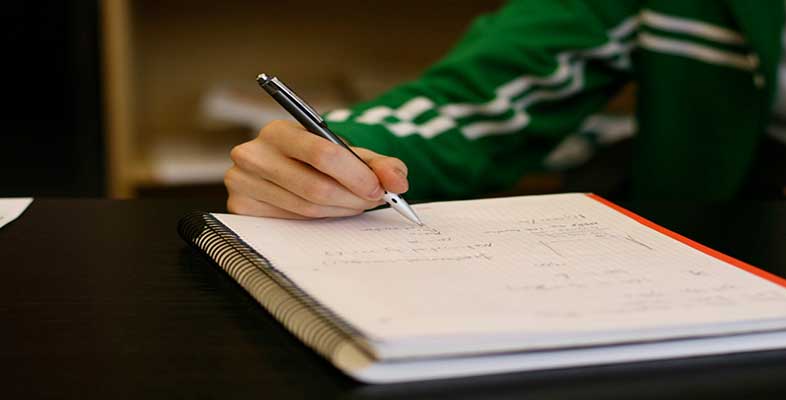
Start this free course now. Just create an account and sign in. Enrol and complete the course for a free statement of participation or digital badge if available.
Essay and report writing skills
Introduction.
Most academic courses will require you to write assignments or reports, and this free OpenLearn course, Essay and report writing skills , is designed to help you to develop the skills you need to write effectively for academic purposes. It contains clear instruction and a range of activities to help you to understand what is required, and to plan, structure and write your assignments or reports. You will also find out how to use feedback to develop your skills.
Find out more about studying with The Open University by visiting our online prospectus [ Tip: hold Ctrl and click a link to open it in a new tab. ( Hide tip ) ] .
Tell us what you think! We’d love to hear from you to help us improve our free learning offering through OpenLearn by filling out this short survey .
Writing a report
Topic outline.
The purpose of a report is often to present relevant information in an ordered way and to make carefully considered suggestions based on that information.
Reports are usually a mixture of fact and opinion, reflecting on key facts and details to offer suggestions to the reader.
Reports can also be used to offer an objective view of a situation, proposing alternatives for the reader to consider.
For example, reports in a workplace might include statistics to support different plans for the future of the business so that people can decide on the best option.
The audience of a report is often someone in charge, for example a teacher, or an employer, so the language and tone of a report tends to be more formal.
- think about the audience that the report is for – are you writing this report for one reader, or for a group of people such as the organisers of an event?
- the impression you want your reader to have of you – usually a report should be impersonal and relatively formal since you are writing to someone who is in charge. You would not normally use slang or contractions ( such as don’t or can’t) .It is usually best to avoid attempts at humour or sarcasm
- the purpose for the report – you may have been asked to make suggestions or recommendations in your report based on personal experience, or to offer an overview of a more complex situation. Try to include a range of topic related vocabulary used appropriately
- how to reassure your reader that your report is going to be useful – i magine if your report was full of emotive words and personal appeals based on your own viewpoint, your reader might not be convinced that you were offering them an objective and accurate evaluation. For your report to be effective you will need to sound calm and polite.
- Identify and group the key information, facts and details your report needs to include before you start writing – the structure of a report is usually in three parts. For example:
- An overview – briefly introduce the topic of the report and the key areas you will consider. Your reader should be able to understand what you will be writing about and why by just reading this section.
- A middle – develop and support the relevant facts and opinions about the topic that you or others have noticed.
- An end – offer a brief summary of your suggestions, recommendations or solutions. Here you might like to include any new points you think should be considered in the future .
- Organise different aspects of the report into paragraphs as appropriate – this will help you to explain, develop and support your points.
- Help your reader to locate the information they need more easily – a report should be well-organised and clear. Reports often use headings to show the reader what information can be found in each section. Sometimes bullet points might also be used to highlight key information to the reader. Do not overdo these, but a precise, short, bulleted list can help to draw your reader’s attention to the key points you are making.
- Connect the points you are making logically – for example, where you are offering suggestions based on points you made earlier you might use a linking word or phrase such as ‘in conclusion’, ‘as a consequence’ or ‘finally’.
- Select activity Example of a report Example of a report
- Select activity Resource Resource

25,000+ students realised their study abroad dream with us. Take the first step today
Here’s your new year gift, one app for all your, study abroad needs, start your journey, track your progress, grow with the community and so much more.

Verification Code
An OTP has been sent to your registered mobile no. Please verify

Thanks for your comment !
Our team will review it before it's shown to our readers.

Report Writing
- Updated on
- Nov 4, 2023

The term “report” refers to a nonfiction work that presents and/or paraphrases the facts on a specific occasion, subject, or problem. The notion is that a good report will contain all the information that someone who is not familiar with the subject needs to know. Reports make it simple to bring someone up to speed on a subject, but actually writing a report is far from simple. This blog will walk you through the fundamentals of report writing, including the structure and practice themes.
This Blog Includes:
What is a report, reporting formats, newspaper or magazine reports, business reports, technical reports, what is report writing, report writing: things to keep in mind, structure of report writing, magazine vs newspaper report writing format, report writing format for class 10th to 12th, report writing example, report writing for school students: practice questions, report writing slideshare.
- Report Writing in 7 steps
Also Read: Message Writing
A report is a short document written for a particular purpose or audience. It usually sets out and analyses a problem often recommended for future purposes. Requirements for the precise form of the report depend on the department and organization. Technically, a report is defined as “any account, verbal or written, of the matters pertaining to a given topic.” This could be used to describe anything, from a witness’s evidence in court to a student’s book report.
Actually, when people use the word “report,” they usually mean official documents that lay out the details of a subject. These documents are typically written by an authority on the subject or someone who has been tasked with conducting research on it. Although there are other forms of reports, which are discussed in the following section, they primarily fulfil this definition.
What information does reporting contain? All facts are appreciated, but reports, in particular, frequently contain the following kinds of information:
- Information about a circumstance or event
- The aftereffects or ongoing impact of an incident or occurrence
- Analytical or statistical data evaluation
- Interpretations based on the report’s data
- Based on the report’s information, make predictions or suggestions
- Relationships between the information and other reports or events
Although there are some fundamental differences, producing reports and essays share many similarities. Both rely on facts, but essays also include the author’s personal viewpoints and justifications. Reports normally stick to the facts only, however, they could include some of the author’s interpretation in the conclusion.
Reports are also quite well ordered, frequently with tables of contents of headers and subheadings. This makes it simpler for readers to quickly scan reports for the data they need. Essays, on the other hand, should be read from beginning to end rather than being perused for particular information.
Depending on the objective and audience for your report, there are a few distinct types of reports. The most typical report types are listed briefly below:
- Academic report: Examines a student’s knowledge of the subject; examples include book reports, historical event reports, and biographies.
- Identifies data from company reports, such as marketing reports, internal memoranda, SWOT analyses, and feasibility reports, that is useful in corporate planning.
- Shares research findings in the form of case studies and research articles, usually in scientific publications.
Depending on how they are written, reports can be further categorised. A report, for instance, could be professional or casual, brief or lengthy, and internal or external. A lateral report is for persons on the author’s level but in separate departments, whereas a vertical report is for those on the author’s level but with different levels of the hierarchy (i.e., people who work above you and below you).
Report formats can be as varied as writing styles, but in this manual, we’ll concentrate on academic reports, which are often formal and informational.
Also Read: How to Write a Leave Application?
Major Types of Reports
While the most common type of reports corresponds to the ones we read in newspapers and magazines, there are other kinds of reports that are curated for business or research purposes. Here are the major forms of report writing that you must know about:
The main purpose of newspaper or magazine reports is to cover a particular event or happening. They generally elaborate upon the 4Ws and 1H, i.e. What, Where, When, Why, and How. The key elements of newspaper or magazine report writing are as follows:
- Headline (Title)
- Report’s Name, Place, and Date
- Conclusion (Citation of sources)
Here is an example of a news report:
Credit: Pinterest
Business reports aim to analyze a situation or case study by implementing business theories and suggest improvements accordingly. In business report writing, you must adhere to a formal style of writing and these reports are usually lengthier than news reports since they aim to assess a particular issue in detail and provide solutions. The basic structure of business reports includes:
- Table of Contents
- Executive summary
- Findings/Recommendations
The main purpose of the technical report is to provide an empirical explanation of research-based material. Technical report writing is generally carried out by a researcher for scientific journals or product development and presentation, etc. A technical report mainly contains
- Introduction
- Experimental details
- Results and discussions
- Body (elaborating upon the findings)
Must Read: IELTS Writing Tips
A report is a written record of what you’ve seen, heard, done, or looked into. It is a well-organized and methodical presentation of facts and results from an event that has already occurred. Reports are a sort of written assessment that is used to determine what you have learned through your reading, study, or experience, as well as to provide you with hands-on experience with a crucial skill that is often used in the business.
Before writing a report, there are certain things you must know to ensure that you draft a precise and structured report, and these points to remember are listed below:
- Write a concise and clear title of the report.
- Always use the past tense.
- Don’t explain the issue in the first person, i.e. ‘I’ or ‘Me’. Always write in the third person.
- Put the date, name of the place as well as the reporter’s name after the heading.
- Structure the report by dividing it into paragraphs.
- Stick to the facts and keep it descriptive.
Must Read: IELTS Sample Letters
The format of a report is determined by the kind of report it is and the assignment’s requirements. While reports can have their own particular format, the majority use the following general framework:
- Executive summary: A stand-alone section that highlights the findings in your report so that readers will know what to expect, much like an abstract in an academic paper. These are more frequently used for official reports than for academic ones.
- Introduction: Your introduction introduces the main subject you’re going to explore in the report, along with your thesis statement and any previous knowledge that is necessary before you get into your own results.
- Body: Using headings and subheadings, the report’s body discusses all of your significant findings. The majority of the report is made up of the body; in contrast to the introduction and conclusion, which are each only a few paragraphs long, the body can span many pages.
- In the conclusion, you should summarize all the data in your report and offer a clear interpretation or conclusion. Usually, the author inserts their own personal judgments or inferences here.
Report Writing Formats
It is quintessential to follow a proper format in report writing to provide it with a compact structure. Business reports and technical reports don’t have a uniform structure and are generally based on the topic or content they are elaborating on. Let’s have a look at the proper format of report writing generally for news and magazines and the key elements you must add to a news report:
To Read: How to Learn Spoken English?
The report writing structure for students in grades 10 and 12 is as follows.
- Heading : A title that expresses the contents of the report in a descriptive manner.
- Byline : The name of the person who is responsible for drafting the report. It’s usually included in the query. Remember that you are not allowed to include any personal information in your response.
- (introduction) : The ‘5 Ws,’ or WHAT, WHY, WHEN, and WHERE, as well as WHO was invited as the main guest, might be included.
- The account of the event in detail : The order in which events occurred, as well as their descriptions. It is the primary paragraph, and if necessary, it can be divided into two smaller paragraphs.
- Conclusion : This will give a summary of the event’s conclusion. It might include quotes from the Chief Guest’s address or a summary of the event’s outcome.
Credit: sampletemplates.com
Credit: SlideShare
Now that you are familiar with all the formats of report writing, here are some questions that you can practice to understand the structure and style of writing a report.
- You are a student of Delhi Public School Srinagar handling a campus magazine in an editorial role. On the increasing level of global warming, write a report on the event for your school magazine.
- On the Jammu-Srinagar highway, a mishap took place, where a driver lost his control and skidded off into a deep gorge. Write a report on it and include all the necessary details and eyewitness accounts.
- As a reporter for the Delhi Times, you are assigned to report on the influx of migrants coming from other states of the country. Take an official statement to justify your report.
- There is a cultural program in Central Park Rajiv Chowk New Delhi. The home minister of India is supposed to attend the event apart from other delegates. Report the event within the 150-200 word limit.
- Write today’s trend of COVID-19 cases in India. As per the official statement. include all the necessary details and factual information. Mention the state with a higher number of cases so far.
- In Jawaharlal Nehru Stadium in New Delhi, a table tennis tournament was held between Delhi Public School New Delhi and DPS Punjab. Report the event in 250-300 words.
Also Read: Formal Letter Format, Types & Samples
Credits: Slideshare
Report Writ ing in 7 steps
- Choose a topic based on the assignment
- Conduct research
- Write a thesis statement
- Prepare an outline
- Write a rough draft
- Revise and edit your report
- Proofread and check for mistakes
Make sure that every piece of information you have supplied is pertinent. Remember to double-check your grammar, spelling, tenses, and the person you are writing in. A final inspection against any structural criteria is also important. You have appropriately and completely referenced academic work. Check to make sure you haven’t unintentionally, purposefully, or both duplicated something without giving credit.
Related Articles
Any business professional’s toolkit must include business reports. Therefore, how can you create a thorough business report? You must first confirm that you are familiar with the responses to the following three questions.
Every company report starts with an issue that needs to be fixed. This could be something straightforward, like figuring out a better way to organise procuring office supplies, or it could be a more challenging issue, like putting in place a brand-new, multimillion-dollar computer system.
You must therefore compile the data you intend to include in your report. How do you do this? If you’ve never conducted in-depth research before, it can be quite a daunting task, so discovering the most efficient techniques is a real plus.
Hopefully, this blog has helped you with a comprehensive understanding of report writing and its essential components. Aiming to pursue a degree in Writing? Sign up for an e-meeting with our study abroad experts and we will help you in selecting the best course and university as well as sorting the admission process to ensure that you get successfully shortlisted.
Ankita Mishra
A writer with more than 10 years of experience, including 5 years in a newsroom, Ankita takes great pleasure in helping students via study abroad news updates about universities and visa policies. When not busy working you can find her creating memes and discussing social issues with her colleagues.
Leave a Reply Cancel reply
Save my name, email, and website in this browser for the next time I comment.
Contact no. *

Leaving already?
8 Universities with higher ROI than IITs and IIMs
Grab this one-time opportunity to download this ebook
Connect With Us
25,000+ students realised their study abroad dream with us. take the first step today..

Resend OTP in

Need help with?
Study abroad.
UK, Canada, US & More
IELTS, GRE, GMAT & More
Scholarship, Loans & Forex
Country Preference
New Zealand
Which English test are you planning to take?
Which academic test are you planning to take.
Not Sure yet
When are you planning to take the exam?
Already booked my exam slot
Within 2 Months
Want to learn about the test
Which Degree do you wish to pursue?
When do you want to start studying abroad.
September 2024
January 2025
What is your budget to study abroad?

How would you describe this article ?
Please rate this article
We would like to hear more.
- How to Cite
- Language & Lit
- Rhyme & Rhythm
- The Rewrite
- Search Glass
How to Write an Educational Report
Educational reports cover a variety of topics, from feedback about a teaching session to reports on the need for additional classrooms and resources. Regardless of the topic of your educational report, you want to make it logical and understandable so your reader sees why you are making certain recommendations. Crafting an educational report becomes easier when you break it down into steps and present your findings in order.
Contextualize the topic of your educational report. Before you begin writing, think about your audience and what they need to know to understand your educational report. This can be done in two or three sentences, as it is an overview, with the details coming later.
Introduce your topic details and indicate your developmental plans for addressing the issues. In each section of your educational report, cover the five "Ws:" who, what, when, where and why. Define any terms your reader may not understand.
Use a top-down formula. Start with the most important points you want to cover in your educational report and then move to topics of lesser concern. When you change ideas, start a new paragraph.
Draft your report in easy-to-understand English. Vary your sentence length and don’t use a big word when a small one will do.
Read your educational report aloud. Listen to how it sounds in terms of professional tone. Put yourself in your reader’s place and assess how you would receive the information. Edit accordingly.
Polish your educational report. Leave your report for a day or so and then return to it with fresh eyes. Correct any typing or grammar mistakes. If you have concerns, ask a colleague with good editing skills to review your report.
Attach any relevant information, such as technical reports on facilities or conference programs that supports your educational report.
- Monash University: Introducing Your Assignment
- CSE: How to Write a Good Report
- Open University: Essay and Report Writing
Jody Hanson began writing professionally in 1992 to help finance her second around-the-world trip. In addition to her academic books, she has written for "International Living," the "Sydney Courier" and the "Australian Woman's Forum." Hanson holds a Ph.D. in adult education from Greenwich University.

Report Writing
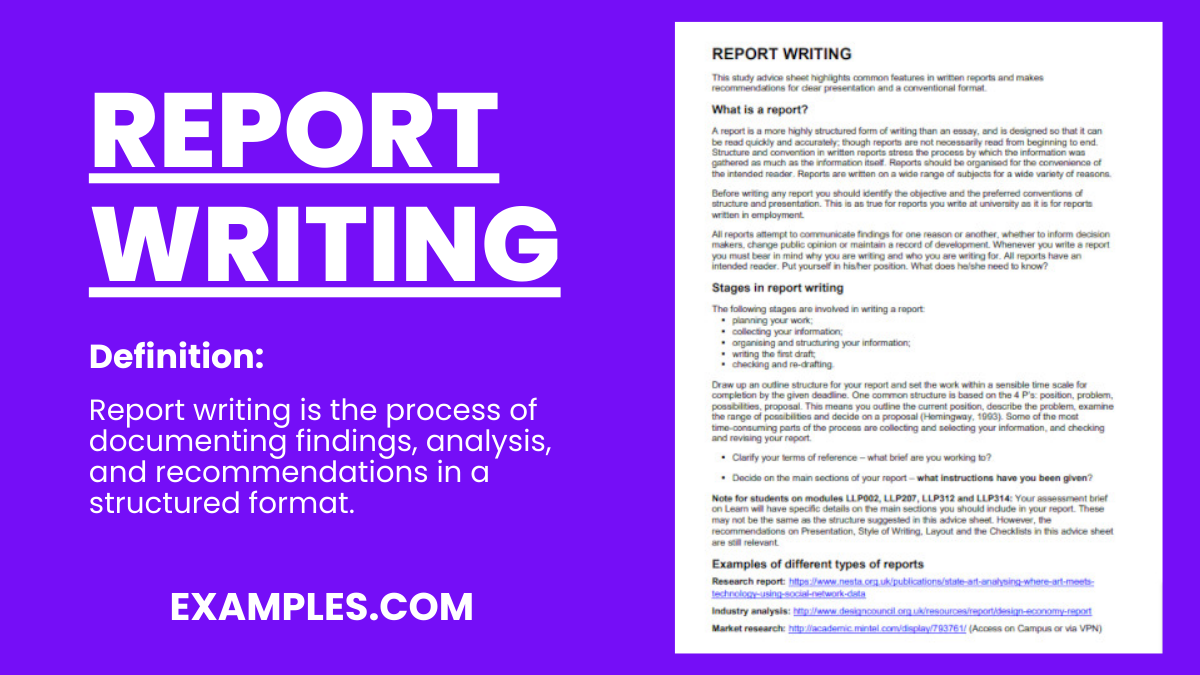
You don’t necessarily have to have great writing skills when you’re writing a report. You just need to know some basic techniques and guidelines along the way to make a truly compelling one.
Furthermore, it is essential and utmost practical to learn and practice business writing when it comes to making reports . It is best to start practicing and writing your reports, so in the long run it won’t be overwhelming for you. You may refer to the examples below for writing a report.
What is Report Writing? Report writing is a structured and formal method of writing, aimed at conveying information or findings in a clear, concise, and factual manner. It typically involves presenting research, analysis, or findings on a specific topic, often for business, scientific, or academic purposes. Reports are characterized by their organized format, including sections such as introduction, methodology, results, and conclusion, and are designed to be easily navigable and comprehensible for the intended audience.
Structure/Format of Report Writing
Title of the report. Your name or the name of the author. Date of submission. Any relevant organizational or departmental information.
Executive Summary
A brief overview of the report’s main points, findings, and recommendations. Usually, this section is written last but placed at the beginning.
Table of Contents
A list of report sections and their page numbers for easy navigation.
Introduction
Clearly state the purpose and scope of the report. Provide background information and context.
Methodology (if applicable)
Describe the research methods, data sources, and tools used to gather information.

Findings/Results
Present the main data, facts, or findings in a structured and organized manner. Use headings, subheadings, and visuals like charts and tables to enhance clarity.
Interpret the data and explain its significance. Discuss trends, patterns, or relationships observed in the findings.
Summarizes the main points of the report and the findings. It may also restate the purpose or objective.
The Best Example of Report Writing
Title: Market Research Report – Consumer Preferences for Mobile Phones Introduction: This report presents the findings of a market research study conducted to understand consumer preferences for mobile phones in the fictitious market of “Techville.” Methodology: We conducted a survey of 500 Techville residents, using both online and in-person questionnaires. The survey included questions about brand preferences, desired features, and price sensitivity. Findings: 1. Brand Preferences: 40% of respondents favored Brand A. 30% preferred Brand B. 20% had no specific brand preference. 10% liked other brands. 2. Desired Features: 60% of participants emphasized camera quality. 25% considered battery life a top priority. 15% prioritized processing speed. 3. Price Sensitivity: 70% of respondents were willing to pay up to $500 for a mobile phone. 20% were willing to spend between $500 and $800. 10% indicated a budget of over $800. Analysis: The results indicate a strong preference for Brand A, likely due to its reputation for camera quality. The demand for longer battery life and affordability in the $500 price range is significant. Conclusion: Consumers in Techville exhibit a clear brand preference and prioritize camera quality, battery life, and affordability when choosing mobile phones. Recommendations for manufacturers include improving camera features and offering budget-friendly options.
Short Report Writing
Title: Quarterly Sales Performance Report Q1 2024 Title Page Report Title: Quarterly Sales Performance Report Q1 2024 Prepared for: XYZ Company Prepared by: Sales Analysis Team Date: April 10, 2024 Executive Summary: A concise overview highlighting the key findings of the sales performance in the first quarter of 2024, showing a 15% increase in sales compared to Q1 of the previous year, with a significant growth in online sales channels. Introduction: Brief introduction to the report, outlining its purpose – to analyze sales performance in Q1 2024 and compare it with Q1 2023. Findings: Overall Sales: Total sales revenue increased by 15% compared to Q1 2023. Highest-selling products were A and B. Sales Channels: Online sales grew by 25%, contributing to 60% of total sales. In-store sales saw a modest growth of 5%. Regional Performance: Region X recorded the highest sales growth (20%). Regions Y and Z showed steady performance. Conclusion: The first quarter of 2024 showed a robust increase in sales, driven primarily by a significant uptick in online sales and strong performance in Region X.
Report Writing for Students
Topic: “The Impact of Online Learning on Student Performance” Executive Summary The report aims to analyze the effects of online learning on student performance. It focuses on academic achievements, student engagement, and adaptability to online platforms. Introduction This report investigates the impact of online learning, which has become increasingly prevalent due to recent global changes. The main objective is to understand how online learning affects students’ academic performance. Methodology Data was collected through surveys and interviews from a sample of 200 high school students. The study also analyzed academic records from the past two academic years. Findings Academic Performance: 60% of students showed improved grades, indicating a positive impact of online learning on academic achievements. Engagement: There was a 30% increase in student engagement in online activities and discussions. Adaptability: Approximately 70% of the students found it easy to adapt to online learning platforms. Analysis The findings suggest that online learning has a significant positive impact on student performance. Enhanced engagement and adaptability to digital platforms contribute to this improvement. Conclusion Online learning has proven to be effective in enhancing student performance. Its flexibility and accessibility play a key role in this success.
How Do You Write a Work Report Example?
[Your Name] [Your Position] [Your Department] [Your Organization] [Date] Title: Monthly Sales Performance Report – October 2023 Executive Summary: This report provides an overview of the sales performance for the month of October 2023, including key achievements, challenges, and recommendations for improvement. Key Achievements: Total sales revenue for October: $500,000, surpassing the target of $450,000. Sales team achieved a 15% growth in the Southeast region. Successful launch of a new product, contributing $50,000 in revenue. Challenges Faced: Increased competition in the Southwest region resulted in a 5% decline in sales. Delays in product shipments from the supplier affected inventory levels. Customer complaints regarding product quality and delivery times increased by 10%. Sales Team Performance: Sales team members achieved their individual sales targets, with an average of 110% attainment. The top-performing sales representative for the month was [Name], exceeding their target by 20%. Recommendations: Address quality and delivery issues to improve customer satisfaction. Implement a proactive inventory management system to avoid future supply chain disruptions. Introduce sales training on objection handling and customer relationship management to enhance performance. Conclusion: October 2023 saw remarkable sales growth and some notable challenges. Addressing these issues and building on our achievements will be essential for sustaining our positive momentum.
Report Writing Topics with Samples
- Report on an Event
- Report on Independence Day
- Report on Teachers Day
- Report on Road Accident
- Report on Accident Report on Car
- Report on Field Visit
- Report on Global Warming
- Report on Social Media
- Report on Sports Day
- Report on Blood Donation Camp
- Report on Fire Accident
- Report on Earthquake
- Report on Diwali Celebrations
- Report on Industrial Visit
- Report on Science Exhibition
Types of Report Writing
Report writing varies widely depending on its purpose and audience. Here are some common types of report writing:
Academic Reports
- Purpose: Analyze or discuss academic topics, report experimental research.
- Characteristics: Clear structure (introduction, body, conclusion), methodology, findings, analysis.
- Examples: Research reports, lab reports, book reviews.
Business Reports
- Purpose: Inform management decisions, present business data, provide recommendations.
- Characteristics: Professional tone, structured, data analysis, conclusions, recommendations.
- Examples: Annual reports, sales reports, financial analysis reports.
Technical Reports
- Purpose: Communicate technical or scientific information.
- Characteristics: Detailed, technical language, graphs/charts, results, conclusions.
- Examples: Engineering reports, scientific study reports, technical evaluation.
Progress Reports
- Purpose: Update on the status of a project or activity.
- Characteristics: Periodic updates, focuses on progress, challenges, future plans.
- Examples: Project status reports, performance reports.
Analytical Reports
- Purpose: Analyze issues/problems, interpret data, provide recommendations.
- Characteristics: Data-driven, analysis, interpretation, conclusions, recommendations.
- Examples: Market analysis reports, policy analysis, feasibility studies.
Formal Reports
- Purpose: Provide thorough, structured information or research.
- Characteristics: Long, detailed, formal structure, extensive appendices.
- Examples: Compliance reports, annual general reports, in-depth research reports.
Informal Reports
- Purpose: Routine internal communication within an organization.
- Characteristics: Shorter, less structured, in forms like memos or emails.
- Examples: Internal updates, brief summaries, memos.
Proposal Reports
- Purpose: Propose plans, projects, ideas, seek approval or persuade.
- Characteristics: Persuasive tone, outlines proposals, benefits, feasibility, implementation steps.
- Examples: Business proposals, research proposals, project proposals.
Each type serves a specific purpose and audience, and the style and format can vary significantly from one type to another. Understanding the specific requirements of the type of report you are writing is crucial for effective communication.
Elements/What to Include in a Report Writing
1. Title Page: Includes the report’s title, the author’s name, date, and other relevant information.
2. Abstract or Executive Summary: A concise overview summarizing the main points, findings, objectives, and conclusions of the report.
3. Table of Contents: Lists all the report’s sections, headings, and subheadings along with their page numbers.
4. Introduction: Introduces the topic, outlines the purpose of the report, and provides background information.
5. Methodology: Describes the methods and procedures used in gathering data or information for the report.
6. Findings or Body: The main part of the report, presenting the data or information found, structured in a logical format with clear headings.
7. Analysis: Involves interpreting the findings, discussing implications, patterns, or problems identified during research.
8. Conclusion: Summarizes the main findings, restating the purpose and highlighting the key points of the report.
1. Formal Report Writing
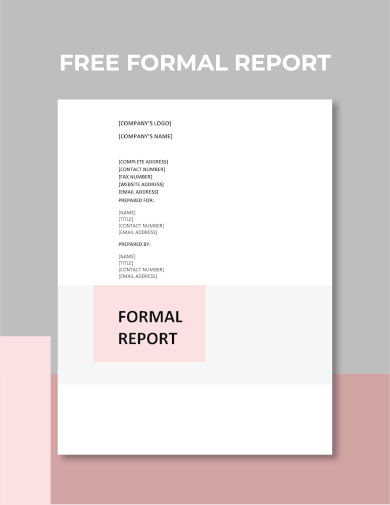
- Google Docs
- Apple Pages
Size: US, A4
2. Free Annual Report Example

3. Sample Audit Report Example
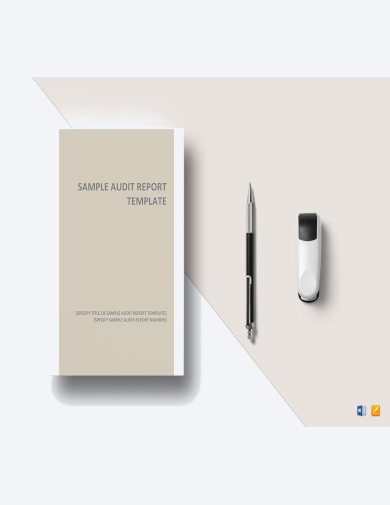
4. Weekly Status Report Example
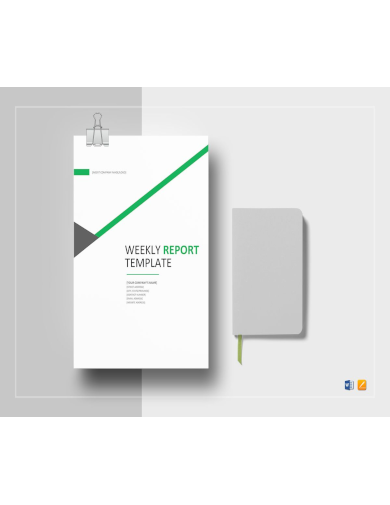
5. Annual Financial Report Example
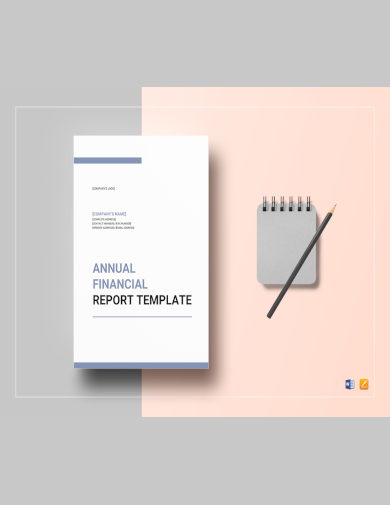
6. Consulting Report Example
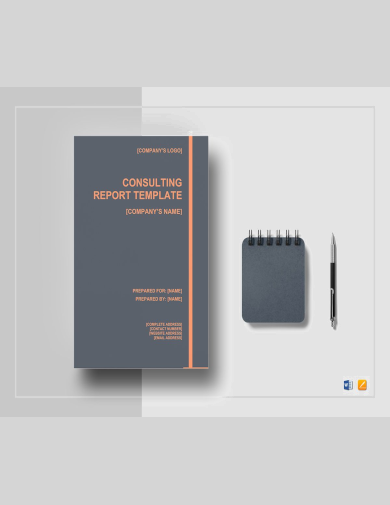
7. Free Monthly Report Example

8. Report Writing Examples
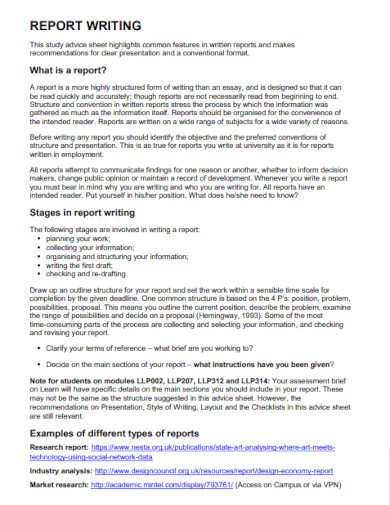
lboro.ac.uk
Size: 134 KB
9. Effective Report Writing Example
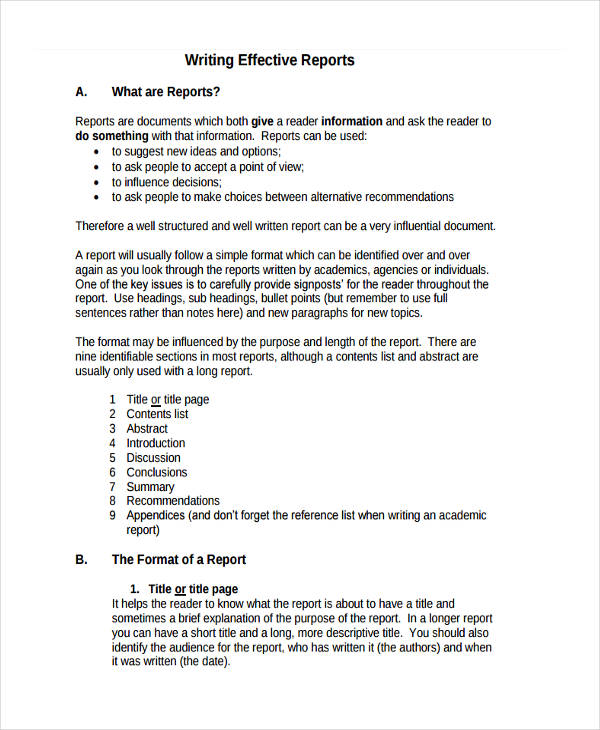
Size: 169 KB
10. Sample Business Report Writing Example
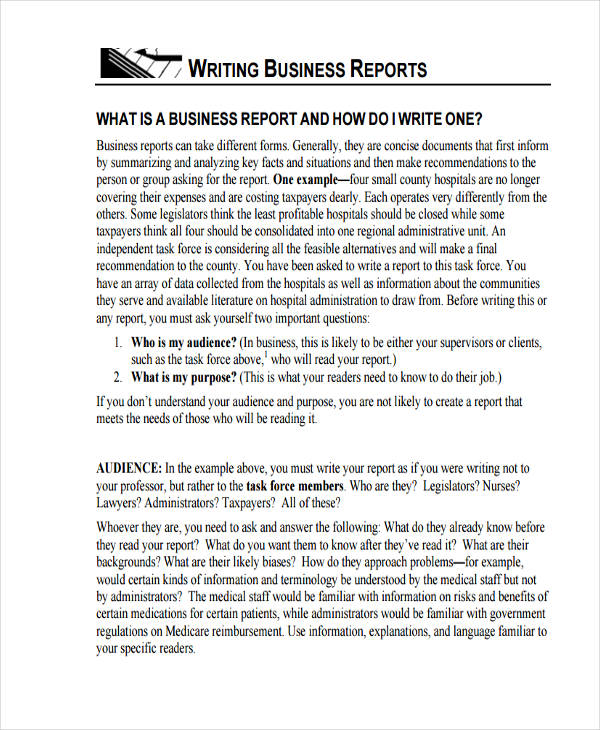
wac.colostate.edu
Size: 151 KB
11. Undergraduate Project Report Writing Example

bradford.ac.uk
Size: 244 KB
12. Scientific Report Writing Example
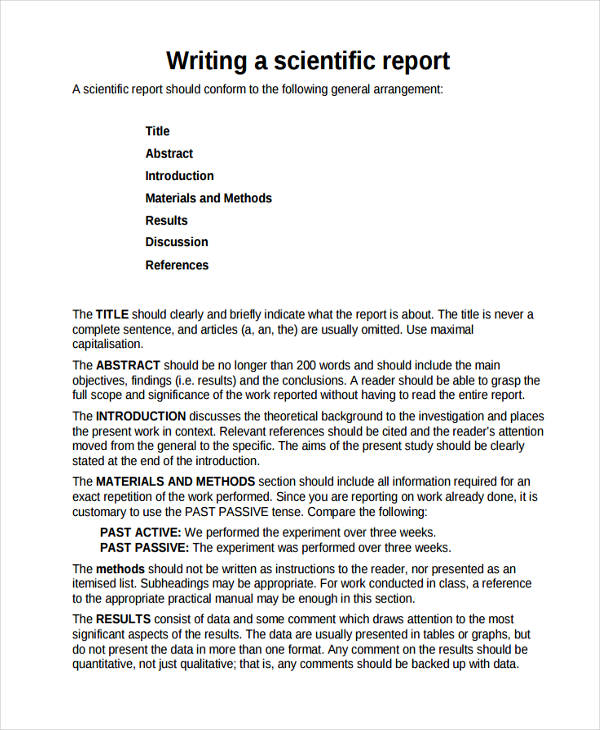
Size: 206 KB
13. Newspaper Report Writing Example
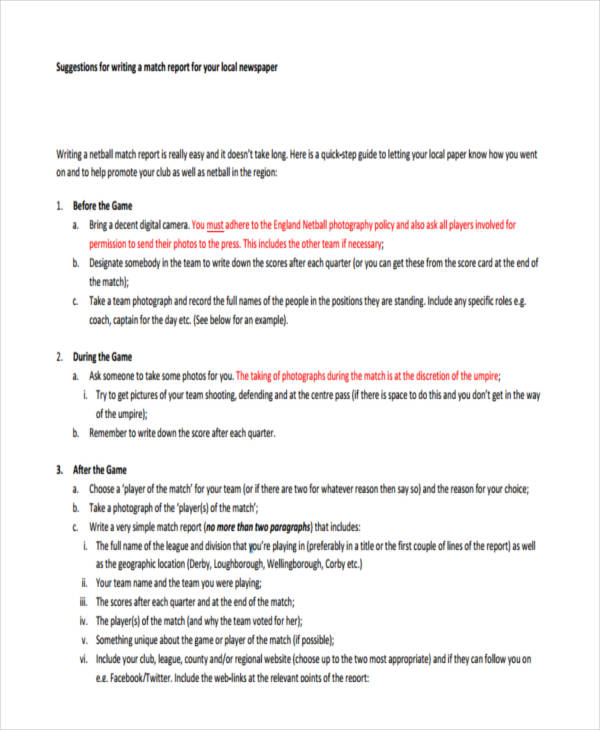
eastmidlandsnetball.co.uk
Size: 365 KB
What Is the Purpose of a Report?
There are two purposes of a report that is done in formal writing and these are on information and communication.
With these two hand in hand, one of the contributing effects of the purpose of a report is help you decide on making the right decisions.
Second would be to develop good relationships in your work due to the effective information and communication that has been transmitted by the report example .
Third and last would be the supervising on the acquired information based on the report on whether if it meets the actual standard of the organization.
14. Effective Formal Report Writing Example
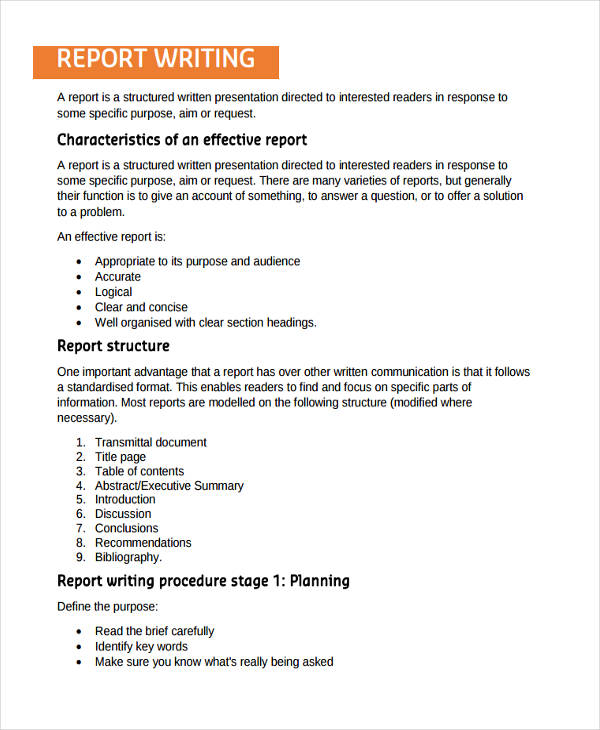
life.curtin.edu.au
Size: 58 KB
15. Basic Audit Report Writing Example
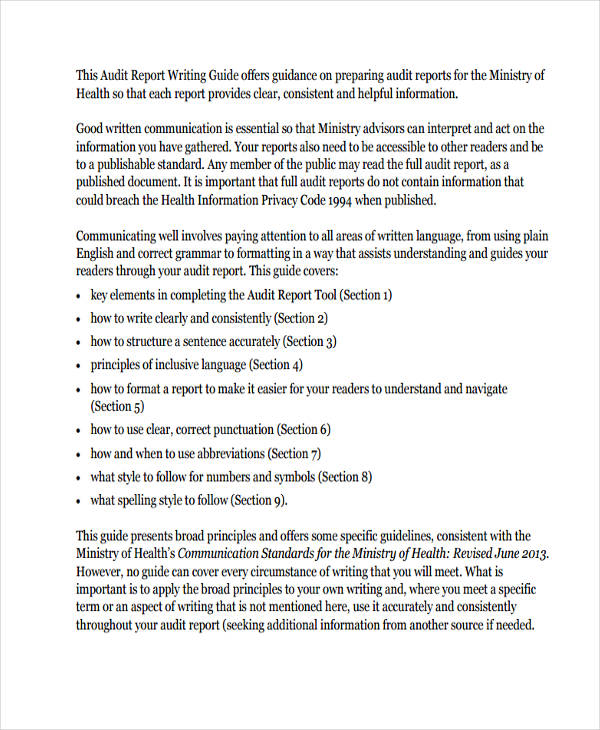
health.govt.nz
Size: 529 KB
16. Sample Research Report Writing Example
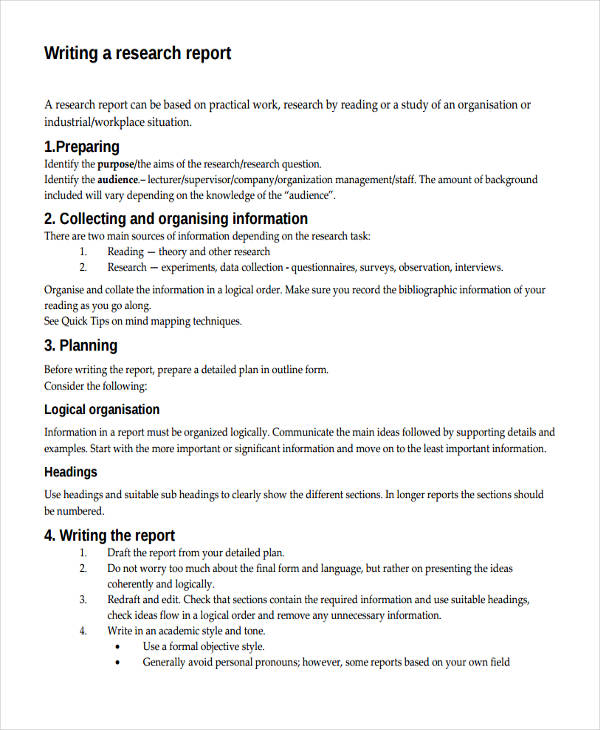
dlsweb.rmit.edu.au
Size: 87 KB
17. Example Student Report Writing
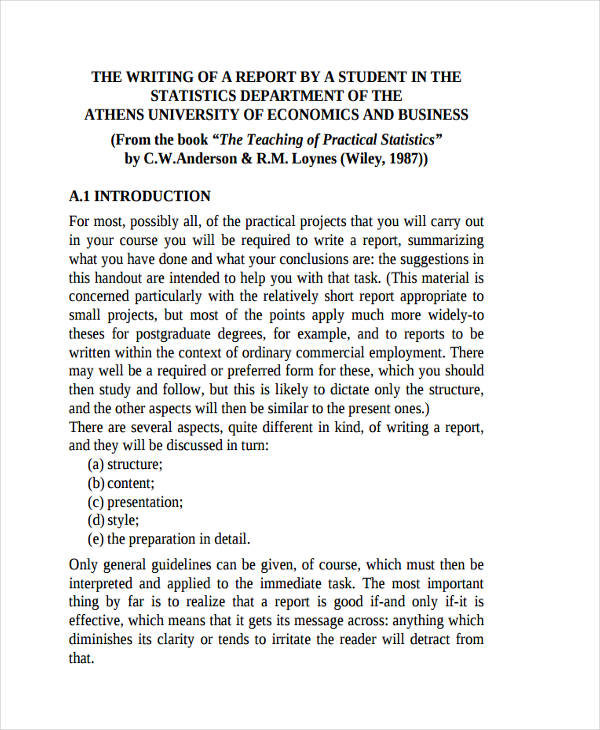
stat-athens.aueb.gr
Size: 27 KB
18. Free Technical Report Writing Example
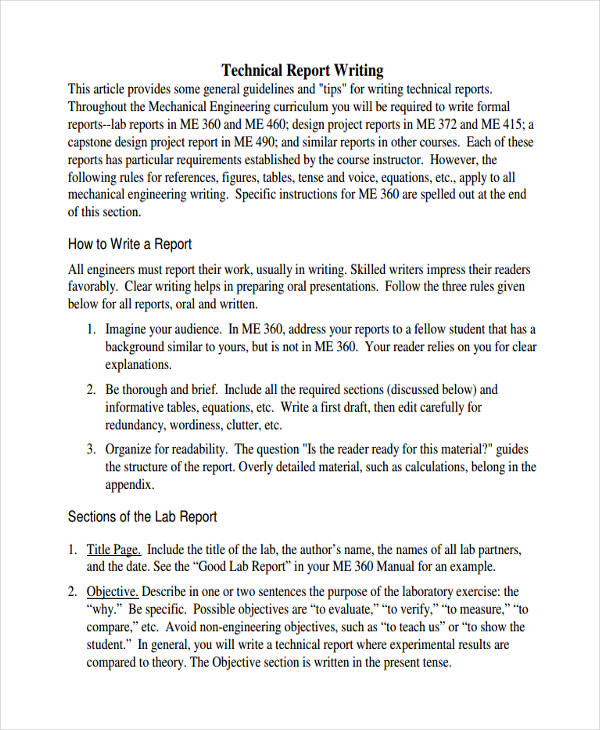
discountpdh.com
Size: 71 KB
19. Free Incident Report Writing Example
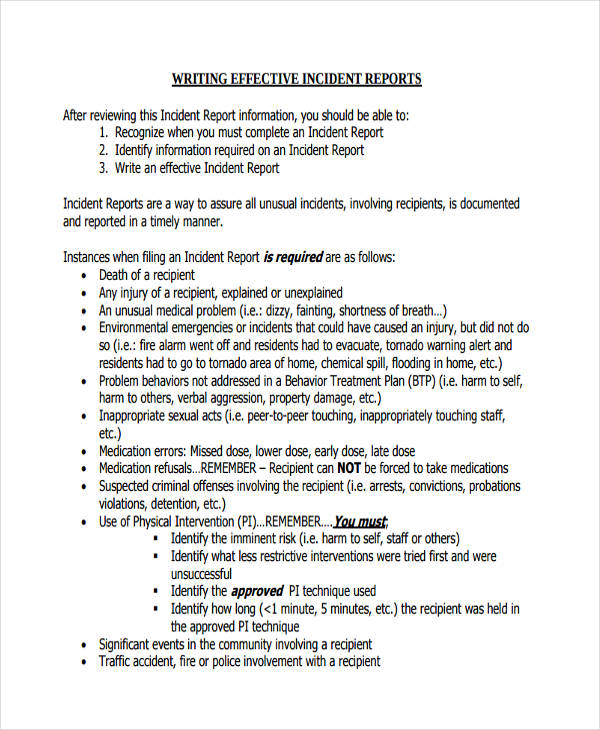
miottawa.org
Size: 122 KB
The Difference between Essay and Report Writing
Although they tend to mean the same thing which is to write about a particular topic, they greatly vary in terms of style and content.
Essay Writing: Essay writing is more on dealing with the writers’ own personal opinion and subjective understanding regarding the topic he/she is writing about.
Report Writing: While on the other hand, report writing is more concern with the facts and is well detailed in explaining and delivering the purpose of the information through a systematic and organized way.
How To Write a Report in 7 Steps
Writing a report involves a series of structured steps to ensure clarity, coherence, and effectiveness. Here’s a detailed guide to the process:
1. Understand the Assignment
- Clarify the Purpose: Determine the primary goal of your report – is it to inform, analyze, persuade, or recommend?
- Know Your Audience: Tailor the content, language, and complexity based on who will read the report.
2. Choose and Research Your Topic
- Select a Topic: If not assigned, choose a topic relevant to the report’s purpose.
- Conduct Research: Gather information from reliable sources. Note down important points, data, and references.
3. Create an Outline
- Structure Your Report: Plan the layout with headings and subheadings. Common sections include Introduction, Methodology, Findings, Conclusion, and Recommendations.
- Organize Your Points: Arrange your information logically, ensuring a coherent flow.
4. Write the Introduction
- Introduce the Topic: Provide background information and context.
- State the Purpose: Clearly articulate the aim of the report.
- Outline the Structure: Briefly mention how the report is organized.
5. Develop the Body
- Methodology: Explain how you gathered or processed information.
- Findings: Present your data or information clearly, using charts or graphs if necessary.
- Analysis: Interpret the findings, discussing implications or problems.
6. Conclude and Recommend
- Summarize Key Points: Briefly restate the main findings.
- Draw Conclusions: Link the findings back to the report’s purpose.
- Make Recommendations: Suggest possible actions or next steps, if applicable.
7. Revise and Finalize
- Review Content: Check for completeness, accuracy, and clarity.
- Edit for Grammar and Style: Ensure the report is free of grammatical errors and maintains a formal tone.
- Format the Report: Consistently apply formatting rules, and include a title page, contents page, and references.
What are the do’s and don’ts of report writing?
Faq’s, how should i write a report.
To write a report, clarify its purpose, gather relevant information, organize your thoughts logically, use a formal tone, provide clear, concise content, cite sources, and proofread meticulously for accuracy and clarity.
What is simple report writing?
Simple report writing is a concise and straightforward method of conveying information or findings in a clear and direct manner, often without extensive analysis or elaborate formatting.
What should be included in a report?
A report should include a clear purpose, structured sections (introduction, methodology, findings, analysis, recommendations, conclusion), relevant data, citations, visuals (if needed), and adhere to a specific format.
Report Generator
Text prompt
- Instructive
- Professional
Create a report on the annual academic performance of students in middle school
Generate a report summarizing the results of a school-wide survey on student satisfaction with cafeteria food.

Report Writing: Educational Tour
A couple of examples to help with your report writing on educational tour.
Table of Contents
An educational tour is an excellent opportunity for students to learn outside of the classroom setting. It provides a chance for them to experience different cultures, explore new places, and gain practical knowledge that they can apply in real-life situations. The main purpose of this tour is to broaden the students’ horizons and enhance their learning experience.
The first destination of the educational tour is the Science Museum. The museum houses a vast collection of exhibits that showcase the latest advancements in science and technology. It is an excellent opportunity for students to learn about various scientific phenomena, including electricity, magnetism, and optics. The exhibits are interactive, allowing students to participate in hands-on activities that help them understand the concepts better. The museum visit is relevant to the tour’s theme of promoting scientific knowledge and encouraging students to pursue careers in science.
The second educational destination is the Historical Museum, which showcases the rich history of the country. The museum features exhibits that highlight significant events in the country’s past, including the struggle for independence and the formation of the government. The visit to the museum is an opportunity for students to learn about the historical significance of the country and its impact on the present. It also promotes the tour’s theme of encouraging students to be knowledgeable about their country’s history.
The third educational destination is the Environmental Park, which is a natural reserve that houses various flora and fauna. The park is an excellent opportunity for students to learn about the importance of preserving the environment and the impact of human activities on the ecosystem. The park visit is relevant to the tour’s theme of promoting environmental awareness and encouraging students to take action to protect the environment.
In conclusion, the educational tour provides an excellent opportunity for students to learn outside of the classroom setting. The tour’s theme of promoting scientific knowledge, historical awareness, and environmental consciousness is evident in the choice of destinations. The tour is an excellent opportunity for students to gain practical knowledge that they can apply in real-life situations, broaden their horizons, and enhance their learning experience.
Educational tours are an excellent way to learn about new places and cultures. Recently, I had the opportunity to go on an educational tour that took me to various destinations. This tour was filled with exciting experiences, and I learned a lot during my trip. In this essay, I will describe my educational tour and the three destinations that we visited.
Our first destination was the local museum, which was dedicated to the history and culture of the region. As soon as we entered the museum, we were greeted with a vast collection of artifacts and exhibits that showcased the region’s rich history. We learned about the indigenous tribes that once inhabited the area and their way of life. The museum also had exhibits that highlighted the region’s flora and fauna, which helped us understand the ecosystem better. Overall, the museum was an excellent way to start our educational tour.
Our next stop was a historical landmark, which was a fascinating experience. The site had a rich history that dated back to the colonial era, and we were able to explore the architecture and significance of the site. The tour guide provided us with a detailed account of the events that took place at the site, and we were able to visualize the events better. We also had the opportunity to see some of the artifacts that were recovered from the site, which added to our learning experience.
Our final destination was a nature reserve, which was a unique experience. We were able to observe and learn about the flora and fauna of the area. The reserve was home to various species of animals and plants, and we had the opportunity to see them up close. The tour guide provided us with valuable information about the ecosystem and how it was being preserved. We also learned about the threats that the ecosystem was facing and the steps being taken to protect it.
In conclusion, my educational tour was a fulfilling experience that allowed me to learn about new places and cultures. The three destinations that we visited provided us with a diverse learning experience that was both educational and exciting. The tour helped me appreciate the importance of preserving our history, culture, and environment. Overall, it was an enriching experience that I will cherish for years to come.
Educational tours are an excellent way to enhance the learning experience of students. These tours provide an opportunity to explore the world outside of the classroom and to gain practical knowledge. In this essay, we will explore the educational value of an educational tour that includes a visit to the Museum of Natural History, a Historical Landmark, and an Art Gallery.
The Museum of Natural History is an excellent place for students to learn about the natural world. The exhibits and displays in the museum are designed to educate visitors about the history of the earth and the various species that have inhabited it. Students can learn about the evolution of life on earth, the diversity of species, and the importance of conservation. The museum also provides interactive learning opportunities, such as hands-on exhibits and educational programs.
Visiting a Historical Landmark provides students with a unique opportunity to learn about the history of a particular place. The landmark may be a building, monument, or site that is significant to the history of a region or country. Students can learn about the historical context of the landmark, the events that took place there, and the people involved. This information can be used to connect to the curriculum and learning objectives, such as understanding the impact of historical events on society.
An art gallery is an excellent place for students to learn about art and its significance in society. The gallery may feature a variety of artwork, such as paintings, sculptures, and installations. Students can learn about the artists, the techniques used, and the historical context of the artwork. Art appreciation and analysis are essential skills that can be integrated with other subjects such as history and literature.
In conclusion, an educational tour that includes a visit to the Museum of Natural History, a Historical Landmark, and an Art Gallery can provide students with a diverse range of learning experiences. These experiences can enhance their understanding of the world around them and help them develop essential skills such as critical thinking, problem-solving, and creativity. Educational tours are an excellent way to suppl
About Mr. Greg
Mr. Greg is an English teacher from Edinburgh, Scotland, currently based in Hong Kong. He has over 5 years teaching experience and recently completed his PGCE at the University of Essex Online. In 2013, he graduated from Edinburgh Napier University with a BEng(Hons) in Computing, with a focus on social media.
Mr. Greg’s English Cloud was created in 2020 during the pandemic, aiming to provide students and parents with resources to help facilitate their learning at home.
Whatsapp: +85259609792
[email protected]


Report Writing on Educational Tour [With PDF]
In this article you are going to learn how to write a report on Educational Tour organize by your school. So with out much delay let’s jump in.

Educational Tour From School
By Ashlyn Tony
February 23, 2018; Karnataka: A bright morning, our tutor came in and announced we are going for a field trip. We were excited but most of us didn’t know what was a field trip and what was the motive behind it. We packed ourselves and led ourselves to our school bus.
During the ride, our tutor explained to us what a field trip was and why it was conducted. We went to a zoological park. It was a different experience from classroom learning. We students grasped the concept much faster. The method of learning through experience was different. We could learn things outside textbooks.
This is done so that students can look into a particular topic from all possible perspectives enabling them to learn everything. It has also been proved that field trips are an excellent way for incorporating knowledge into young minds. This also helps students to learn and understand topics on their own without further explanations.
They help indirect learning and help students in finding things by themselves which is better than spoon-feeding information. This experience helps students to retain in their memories what they have learnt for a much longer period.
Field Trip To A Butterfly Garden
By Rachel Harris
January 1, 2019; New Delhi: A field trip to a nearby butterfly garden was arranged for the kindergarten students. They were all excited about the idea of visiting a butterfly garden. We took the school bus to the garden. The students were so excited to see different types of butterflies.
Students observed different varieties and their teachers helped them understand the different features. They studied the different stages of growth. They saw a huge variety of butterflies. The students were so excited. By the end, students started recognising the different varieties of butterflies. They learnt all they could about Butterflies.
Also, they used this experience for instilling in students the importance of nature. They understood that the reason behind why they could not see butterflies like before is because of the disturbances humans create in the environment.
They were also taught the importance of trees in nature. They pledged that they would not hurt mother nature and will prevent unnecessary cutting of trees. Thus, the field trip was successful.
College Field Trip
By Saira Rajput
March 2, 2016; Bombay: We students were looking forward to the field trips. We were eagerly waiting for the days to come. We had pre-planned everything. Every single detail was planned and everything was set. We were visiting places with magnificent architectural designs.
The different varieties of ideas used made us think about the brilliance of the architecture. The designs, mural paintings, the statues, and the engraving on the walls. For some of us, this was the first experience. We learned about things that one should think about before planning and executing architectural designs.
This trip also taught us about the importance of precision in planning a design. One should be able to foresee everything before starting the actual construction. The quality of the materials, the materials used and also how much is the design applicable in a particular place.
Since some materials cannot be used in some climatic conditions, one should take utmost care in selecting materials for the construction. The trip made us realise our potential and also the importance of planning and precision in our field.
Field Trip To A Cow Farm
By Mark Anthony
September 5, 2015; Gujarat: This field trip was planned so as to make students understand how a farm works. On reaching the farm, students saw a large number of cows, of different varieties. One could see the huge machines used for milking the cows. The farm had a large number of workers. There was a veterinarian for weekly checkups.
There were employees cleaning the farms. There were separate employees for each pair of cows. Cows at this farm were given high-protein foods. The sheds were cleaned regularly to control diseases that might affect the cows. One could see the care given to the cows by looking at them. After the milking process, they are sent to a nearby plant for pasteurization and packaging.
There are special sheds for pregnant cows so as to give them special care. The calves are very well taken care of. The students could understand the importance of cleanliness and regular checkups. This experience made the students realise something new and made them learn new things.
There You Have It
So you have seen the example reports on Educational Tour, I hope these examples indeed help you.
Do let me know if you have any other topic ideas that you want me to cover by leaving a quick comment just below the article.
More from English Compositions
- Write Letter to the Editor about Poor Public Bus Service
- Madhyamik English Writing Suggestion 2022 [With PDF]
- Report Writing on Annual Sports Day Celebration in Your School [2023]
- Write a Report on Road Accident [4 Examples] 2023 Updated
- Report Writing Format | How to Write a Report | Example [PDF]
- Write a Diary Entry on Your Trip to an Amusement Park
- Write a Letter to Your Friend about Your Educational Tour
- Write a Letter of Complaint to a Book Dealer for the Delay in the Delivery of Books
- [FREE PDF] From The Diary Of Anne Frank MCQs | CBSE Class 10 English Chapter 4 [TERM 1]
- Write a Letter to Your Friend Describing How You Caught a Thief
- Write a Letter to Your Friend Telling Him About Your Visit to Shimla with Your Parents
- Short Essay on My Adventurous Trip [100, 200, 400 Words] With PDF

Report Writing And Its Significance In Your Career
You reach the office at around 9.00 AM, switch on your system, and start working. It’s a usual workday for…

You reach the office at around 9.00 AM, switch on your system, and start working. It’s a usual workday for you until your manager comes to your desk and asks you to create a sales report. That’s the first time you’ve got such a task, and find yourself struggling with basic questions such as, “What’s a report?” and “How do I write one?”
What Is Report Writing?
Elements of report writing, importance of report writing.
You must have heard the term ‘report writing’ before.
According to the commonly known definition of report writing, a report is a formal document that elaborates on a topic using facts, charts, and graphs to support its arguments and findings.
Any report—whether it’s about a business event or one that describes the processes of various departments in a company—is meant for a particular type of audience.
But why do you think your manager wants you to create a report?
One simple answer is: an elaborate report prepared with evaluated facts helps solve complex problems. When managers come across certain business situations, they ask for comprehensive and well-thought-out reports that can help them design business plans.
Once you have an idea about what a report is, the next step is to understand how you can write one.
There are different types of reports, and each has a specific structure, usually known as ‘elements of the report’.
While we tell you what the elements of report writing are, if you want detailed guidance, you can go for Harappa Education’s Writing Proficiently course that talks about the popular PREP (Point of starting, Reason, Evidence, and Point of ending) model of report writing.
Every report starts with a title page and a table of contents, after which come the main sections–the executive summary, introduction, discussion, and conclusion.
Executive Summary:
Do you remember summary writing for English class during school days? You were asked to read a story or passage and write a summary, including the important takeaways. ( ambien )
That’s exactly what you are expected to do in a report’s executive summary section. This section presents a brief overview of the report’s contents. You should present the key points of the report in this section.
But why is it important to write an executive summary at the start of the report?
Firstly, the summary will help readers better understand the purpose, key points, and evidence you are going to present in the report. Secondly, readers who are in a hurry can read the summary for a preview of the report.
Here are some specifics that will help you write a clear and concise summary:
Include the purpose of your report and emphasize conclusions or recommendations.
Include only the essential or most significant information to support your theories and conclusions.
Follow the same sequence of information that you have used in the report.
Keep the summary length to 10-15% of the complete report.
Try not to introduce any new information or point in summary that you haven’t covered in the report.
The summary should communicate the message clearly and independently.
Introduction:
The introduction section should:
Briefly describe the background and context of the research you have done.
Describe the change, problem, or issue related to the topic.
Define the relevant objectives and purpose of the report
Give hints about the overall answer to the problem covered in the report.
Comment on the limitations and any assumptions you have made to get to the conclusion.
Discussion:
This section serves two purposes:
It justifies the recommendations.
It explains the conclusions.
While you are writing the discussion section, make sure you do the following:
Present your analysis logically.
If needed, divide the information under appropriate headings to improving readability and ease of understanding.
Explain your points and back up your claims with strong and evaluated evidence.
Connect your theory with real-life scenarios
Conclusion:
The last key element of report writing is the conclusion section. Present the conclusion as follows:
- The primary conclusion should come first.
Identify and interpret the major problems related to the case your report is based on.
Relate to the objectives that you have mentioned in the introduction.
Keep the conclusion brief and specific.
Before you start writing a report, it’s important to understand the significance of the report. It’s also crucial to research independently instead of relying on data and trends available on the internet, besides structuring the report properly. Here’s why:
Decision-Making Tool
Organizations require a considerable amount of data and information on specific topics, scenarios, and situations. Managers and decision-makers often use business reports and research papers as information sources to make important business decisions and reach solutions.
Another reason that adds to the significance of report writing is that it is a collection of evaluated information.
Different types of activities by different departments define an organization. Think of the departments your organization has–development, sales, distribution, marketing, HR, and more. Each department follows defined processes and protocols that require many small and large activities on a daily basis.
It is impossible for the management to keep an eye on the different activities in each department.
That’s where the reports can help. With every department writing and maintaining periodic reports, keeping a tab of ongoing activities becomes easier for the management.
Professional Improvements
During the annual appraisal cycle, your manager will ask you to write reports to explain your position, level of work, and performance.
If you have ever wondered how your manager decided to promote your colleague and not you, the answer may lie in his well-presented report.
Quick Source For Problem-Solving
There’s no denying that managers require accurate information on various topics to make quick decisions. Often due to urgency, managers only rely on business reports as an authentic source of information. Almost every employee would have witnessed a situation that needed the manager’s attention urgently. Reports come in handy during such situations.
Report writing is a significant exercise in many ways for your professional life. If you are not well-versed with it already, you must start working on your report writing skills now. For more help or guidance to learn this new skill, sign up for Harappa’s Writing Proficiently course.
Make the most of your time at home and master this new skill. Work on many assignments, improve your skills, and become a pro at report writing.
Explore our Harappa Diaries section to learn more about topics related to the Communicate habit such as the Importance of Writing Skills and the Cycle of Communication .

Philippine students suffer in wilting heat, thwarting education efforts
- Medium Text

Sign up here.
Reporting by Adrian Portugal, Writing by Neil Jerome Morales; Editing by William Mallard
Our Standards: The Thomson Reuters Trust Principles. New Tab , opens new tab

World Chevron

Mississippi Republicans revive bill to regulate transgender bathroom use in schools
A group of Republican women from throughout the state watch procedures in the Senate chamber at the state Capitol in Jackson, Miss., Thursday, May 2, 2024. (AP Photo/Rogelio V. Solis)
Mississippi State Sen. Brice Wiggins, R-Pascagoula, gestures while speaking at the well before the body in the Senate chamber at the state Capitol in Jackson, Miss., Thursday, May 2, 2024. (AP Photo/Rogelio V. Solis)
Mississippi State Sen. Derrick Simmons, D-Greenville, gestures while speaking at the well before the body in the Senate chamber at the state Capitol in Jackson, Miss., Thursday, May 2, 2024. (AP Photo/Rogelio V. Solis)
Mississippi State Sen. Angela Hill, R-Picayune, addresses the legislators in the Senate Chamber at the state Capitol in Jackson, Miss., Thursday, May 2, 2024. (AP Photo/Rogelio V. Solis)
Mississippi State Sen. Bradford Blackmon, D-Canton, asks a question in the Senate chamber at the state Capitol in Jackson, Miss., Thursday, May 2, 2024. (AP Photo/Rogelio V. Solis)
Mississippi State Senate President Pro Tempore Sen. Dean Kirby, R-Pearl, holds a folder with files for the Senate Rules Committee, in the Senate Chamber at the state Capitol in Jackson, Miss., Thursday, May 2, 2024. (AP Photo/Rogelio V. Solis)
Mississippi State Rep. Joey Hood, R-Ackerman, explains a bill to regulate transgender people’s use of bathrooms, locker rooms and dormitories in public education buildings, before the House at the state Capitol in Jackson, Miss., Thursday, May 2, 2024. (AP Photo/Rogelio V. Solis)
Mississippi State Rep. John Faulkner, D-Holly Springs, asks a question on a bill to regulate transgender people’s use of bathrooms, locker rooms and dormitories in public education buildings, before the House at the state Capitol in Jackson, Miss., Thursday, May 2, 2024. (AP Photo/Rogelio V. Solis)
Mississippi State Rep. Jansen Owen, R-Poplarville, asks a question regarding a bill to regulate transgender people’s use of bathrooms, locker rooms and dormitories in public education buildings, before the House at the state Capitol in Jackson, Miss., Thursday, May 2, 2024. (AP Photo/Rogelio V. Solis)
Mississippi State Rep. Fabian Nelson, D-Jackson, asks for a clarification on a bill to regulate transgender people’s use of bathrooms, locker rooms and dormitories in public education buildings, before the House at the state Capitol in Jackson, Miss., Thursday, May 2, 2024. (AP Photo/Rogelio V. Solis)
- Copy Link copied
JACKSON, Miss. (AP) — Mississippi’s Republican-led Legislature completed a last-ditch effort Thursday to revive a bill to regulate transgender people’s use of bathrooms , locker rooms and dormitories in public education buildings.
Lawmakers pushed the proposal through the House and Senate in the final days of their four-month session after negotiations between the chambers broke down Monday on an earlier proposal. Republicans said they received a flurry of messages urging them to bring the bill back to life.
“This probably, to a lot of our constituents and to a lot of people in this chamber, is probably the most important bill that we brought up,” said Senate President Pro Tempore Dean Kirby, a Republican.
The legislation would require all public education institutions to equip their buildings with single-sex restrooms, changing areas and dormitories.
People would only be allowed to enter spaces that correspond to their sex assigned at birth, regardless of their appearance or any procedures they’ve had to affirm their gender identity. Those who violate the policy could be sued, but schools, colleges and universities would be protected from liability.
Democrats said the bill would put transgender people at risk. They also criticized Republicans for spending time on the issue as other legislative priorities remained unfinished.
“It just baffles me that we have things we can do to improve the state of Mississippi for all people, for all people, but we get so pumped on something that’s national politics,” said Rep. Jeffrey Hulum III, a Democrat. “It is not my job to criticize how people live their lives.”
Republicans said they were standing up for female family members on college campuses and pointed to several Republican women, wearing red, as they looked on from the Senate gallery.
One of those women was Anja Baker, a member of the Mississippi Federation of Republican Women from the Jackson suburb of Rankin County. Baker said she works with social service providers and was concerned women would be crowded out of spaces they rely on.
“They only have so many resources, and they need to have their locations and resources protected for the women that need them instead of getting caught in a game of identity politics,” Baker said.
Advocacy groups emailed her and other Republican women late Wednesday urging them to show up Thursday at the Capitol. That came after an initial measure mandating single-sex spaces stalled, causing an embittered back-and-forth between top legislators.
Just before a Monday night deadline, the House offered a plan that would let people file lawsuits seeking monetary damages if someone uses a bathroom not assigned to their gender, said Senate Judiciary A Committee Chairman Brice Wiggins, a Republican. Wiggins said that made it an unacceptable “trial lawyer bill.”
House Judiciary A Committee Chairman Joey Hood, also a Republican, said the Senate forced the House into accepting a weaker proposal. The bill would let people sue, but they would be unable to claim compensatory damages from any lawsuit. As a result, Hood and other House members said the bill they ultimately approved would likely fail to deter people from entering spaces that don’t align with their sex assigned at birth.
Hood said he hopes the Legislature would introduce legislation in 2025 with stronger penalties.
Another proposal failed this year that would have denied the legal recognition of transgender people by writing into law that “there are only two sexes, and every individual is either male or female.”
In 2021, Republican Gov. Tate Reeves signed legislation to ban transgender athletes from competing on girls’ or women’s sports teams. Last year, he signed a bill to ban gender-affirming hormones or surgery for anyone younger than 18.
The Mississippi proposals were among several bills being considered in state legislatures around the country as Republicans try to restrict transgender people’s access to gender-affirming care, bathrooms and sports, among other things.
Michael Goldberg is a corps member for the Associated Press/Report for America Statehouse News Initiative. Report for America is a nonprofit national service program that places journalists in local newsrooms to report on undercovered issues. Follow him at @mikergoldberg .

- International edition
- Australia edition
- Europe edition
Manhattan DA investigating after officer fired gun inside Columbia University - as it happened
Incident, which did not result in injuries, under review, while in California students and faculty condemn police crackdown at UCLA. This blog is now closed.
- More than 2,000 pro-Palestinian protesters arrested across US campuses
- US students: share your experience of the campus protests
- 4d ago Today's recap
- 4d ago US students: share your experience of the pro-Palestinian campus protests
- 5d ago This day so far
- 5d ago Columbia students say government to investigate anti-Palestinian discrimination
- 5d ago LA mayor condemns 'vandalism and violence' at UCLA
- 5d ago US campus arrests pass 2,000 – report
- 5d ago Interim summary
- 5d ago Pulitzer prize board recognizes work of US student journalists covering protests
- 5d ago Columbia's association of university professors call for no-confidence vote against Columbia president Minouche Shafik
- 5d ago Biden says 'no' to calling in National Guard for pro-Palestine college protests
- 5d ago Biden says 'violent protests are not protected. Peaceful protest is'
- 5d ago Joe Biden expected to speak on pro-Palestine campus protests
- 5d ago UCLA encampment cleared and more than 100 people detained
- 5d ago More protests near now-raided UCLA encampment
- 5d ago Video shows police pushing back demonstrators linking arms
- 5d ago California police move in to dismantle pro-Palestinian protest camp at UCLA
- 5d ago Police reinforcements arrive at UCLA, reports the BBC
- 5d ago UCLA Gaza protesters in tense standoff with police – video
- 5d ago Summary
- 5d ago Over 1,000 protesters present on campus at UCLA
- 5d ago Hundreds of police in riot gear are gathered on UCLA campus
- 5d ago US police expand efforts to dismantle student protests across the country
- 5d ago UCLA protesters told to disperse or face arrest
- 5d ago University police reportedly tell UCLA protesters to disperse
- 5d ago Donald Trump praises police response to New York campus protests and condemns demonstrators
- 5d ago Police reportedly poised to dismantle UCLA protests
- 5d ago UCLA police say campus leadership "owns the results of their decisions"
- 5d ago Police arrest 17 on University of Texas in Dallas campus
- 5d ago Fordham University requested police assistance
- 5d ago Arrests at New York's Fordham Univeristy
- 5d ago ‘It was terrifying’: UCLA students describe violent attack on Gaza protest encampment
- 5d ago University of Texas in Dallas reportedly requested assistance from police
- 5d ago Officers make arrests at pro-Palestinian protests in Dallas and New York

LA mayor condemns 'vandalism and violence' at UCLA
Karen Bass , the Los Angeles mayor, condemned “harassment, vandalism and violence” at UCLA’s campus in a statement released Thursday afternoon.
In her statement, Bass did not elaborate on which incidents of violence she was referring to. Student-led protesters on Wednesday were attacked by counter-demonstrators, leaving at least one student with severe injuries.
Here’s the full statement from Bass:
Every student deserves to be safe and live peacefully on their campus. Harassment, vandalism and violence have no place at UCLA or anywhere in our city. My office will continue to coordinate closely with local and state law enforcement, area universities and community leaders to keep campuses safe and peaceful.
Today's recap
At least 2,000 people have arrested for participating in pro-Palestinian protests on US campuses. Student protesters, faculty and others have sustained severe injury as police raided several encampment protests across the US overnight.
Here’s a summary of the developments today, from Guardian US staff across the country:
At least 200 people were arrested at the University of California, Los Angeles (UCLA) on Thursday , the Associated Press reported. The latest figure brings the nationwide total of arrests to more than 2,000 at dozens of college campuses since police cleared an encampment at Columbia University on 30 April.
The Pulitzer prize board publicly recognized the work of student journalists across the US who are covering pro-Palestin ian protests on their campuses. The board praised the work of student journalists at Columbia University, where the Pulitzer prizes are located, for documenting the events on campus as New York police raided student-led encampments on 30 April.
An officer fired a gun inside Columbia University’s Hamilton Hall, and the incident is under review by the Manhattan district attorney, Alvin Bragg. The news was first reported by the outlet The City . No one was injured, according to Doug Cohen, a spokesperson with Bragg’s office, who told the AP that no students had been in the immediate vicinity.
Joe Biden condemned violent protests, including vandalism, trespassing and forcing classes to be cancelled, during remarks from the White House . “We are not an authoritarian nation where we silence people and squash dissent … but neither are we a lawless country,” he said.
At the conclusion of his speech, Biden said he did not think the National Guard should intervene in the protests , while responding to questions from journalists. Biden added that the campus unrest had not made him reconsider any policies in the Middle East.
The Gaza solidarity protest encampment at Rutgers University is being peacefully disassembled by students after meeting with university administration and coming to a resolution. Students at Northwestern and Brown have also been able to reach deals with their school administrations. In Canada, University of Toronto officials reversed a previous 10pm deadline for protesters to disperse, and said an encampment could stay if it remained peaceful.
The largest union of academic workers will hold a strike-authorization vote as early as next week in response to how universities have cracked down on students’ Gaza protests. The union represents more than 48,000 graduate student workers throughout the University of California system. Meanwhile, the Columbia University chapter of the American Association of University Professors (AAUP) called for a vote of no confidence against Columbia president Minouche Shafik.
Faculty at Pomona College have voted to divest from Israel, weeks after protest ers at the liberal arts campus were arrested. The faculty at the school in Claremont, California, have demanded divestment from “weapons manufacturers and companies complicit in human rights violations committed by the Israeli government”.
The Travis county attorney general’s office said there was no evidence to back claims by the University of Texas at Austin that people among the pro-Palestinian demonstrators on campus had “guns, buckets of large rocks, bricks, steel-enforced wood planks, mallets and chains”. The attorney general said that the high numbers of misdemeanor arrests of protesters were unsustainable.
In Canada, University of Toronto announces it will allow protest encampment to stay
Reversing a previous 10 pm deadline for pro-Palestine demonstrators to disperse, University of Toronto officials said that a protest encampment could remain as long as it stayed peaceful, the Toronto Star reported.
University of Toronto says encampment protesters calling for it to ‘divest’ from Israel can stay for now https://t.co/Em6Bvu0COB — Toronto Star (@TorontoStar) May 3, 2024
How big are today’s US campus protests compared to those in the 1960s?
Robert Cohen, a New York University historian, told the AP that the scale of today’s pro-Palestinian student protests don’t yet match the anti-war protests of the Vietnam War era.
“I would say that this is the biggest in the United States in the 21st century,” said Cohen. “But you could say: ‘Well, that’s like being the tallest building in Wichita, Kansas.’”
Another contrast is how quickly university administrators are cracking down:
Another difference that has struck observers is the quick crackdown by campus authorities. In 1968, students occupied Columbia’s Hamilton Hall for nearly a week before authorities moved in. The bust – when it finally came – saw more than 700 arrested. “It’s funny because Columbia is very proud of ... Columbia students’ history of activism,” said Ilana Gut, a senior at the university’s sister school, Barnard College. “So their attitudes toward the modern-day activists, at least in the eyes of protestors, is very ironic – that they’re so proud of their past protestors, but so violently repressive of their modern-day ones.”
The Los Angeles Police Department made no arrests after a night of violence at UCLA. But the group chats are on it.
On Tuesday night, a pro-Palestinian student encampment at UCLA was brutally attacked by what the university’s chancellor called “a mob of instigators”. Many of the attackers covered their faces: some were dressed in black, with white masks.
The attacks on the protest camp went on for an estimated four hours before law enforcement finally intervened, a delay that sparked wide condemnation, including from California’s governor. And LAPD, which eventually was asked to come to campus to respond to the violence, later announced that they had made zero arrests.
In the absence of any immediate legal action from law enforcement, the LA Times reports , “online sleuths” from around the world have been sharing and scrutinizing video footage from the UCLA attacks, in an attempt to identify the perpetrators and hold them accountable.
Who attacked the pro-Palestinian encampment at @UCLA ? Online sleuths are working to find out. https://t.co/DTszH1YYAo @brittny_mejia @jvgarrison @MattHjourno — Teresa Watanabe (@TeresaWatanabe) May 3, 2024
“This is where we’re at now,” Brian Levin, the founding director of the Center for the Study of Hate and Extremism at Cal State San Bernardino, told the LA Times. “People feel for their own protection that they have to bring their own goggles [to protests to protect from teargas], and they also have to find their own assailants.”
AP: Police detain man who briefly accelerated toward pro-Palestin ian demonstrators
This is Lois Beckett, continuing our live news coverage from Los Angeles. The AP has an update from Portland State University in Oregon:
Police said Thursday they detained the driver of a white Toyota Camry who briefly accelerated toward a crowd of pro-Palestinian demonstrators at Portland State University in Oregon, then ran off spraying what appeared to be pepper spray toward protesters who confronted him. The man was taken to a hospital on a police mental health hold, the Portland Police Bureau said in a written statement late Thursday afternoon. They did not release his name. People screamed as the vehicle accelerated from a stop toward the crowd on Thursday afternoon, but the driver braked before it reached anyone. Demonstrators approached the car and began striking it, and the driver exited and sprinted off while aiming the spray toward those trying to catch him. Police said they found the driver later and took him into custody.

After New York City mayor, Eric Adams , repeatedly claimed that “outside agitators” were responsible for escalations that prompted an overwhelming law enforcement crackdown, the NYPD issued numbers indicating that a third of those arrested at Columbia were not students.
On Thursday, the NYPD issued a press release that said among those arrested at Columbia, “approximately 29% of individuals were not affiliated” with the school, while 60% of people arrested at the CCNY protests were not affiliated with the school. It was not immediately clear how the police were defining “affiliation”, and the release did not break down arrest figures in further detail.
“What we have seen, and what has been made clear by the evidence emerging after this week’s arrests, is that professional, external actors are involved in these protests and demonstrations,” the NYPD commissioner, Edward Caban, said in the release. “These individuals are not university students, they are not affiliated with either the institutions or campuses in question, and they are working to escalate the situation.”
The Guardian requested confirmation of receipt of arrest lists from both Columbia University and the City College of New York (CCNY), and asked if the institutions planned to divulge details breaking down the numbers of arrests. Neither immediately responded.
After Joe Biden said on Thursday that the campus demonstrations had not influenced his views on Middle East policies and and characterized campus demonstrators as violent, the College Democrats emphasized the power of the youth vote.
“College Democrats’ votes are not to be taken for granted by the Democratic Party. We reserve the right to criticize our party when it fails to listen to us,” the group posted on X.
It’s no surprise that young people are losing hope in the democratic process when neither party aims to listen to us. Make no mistake— @TheDemocrats cannot win this November without the youth vote. — Sohali Vaddula (@SohaliV) May 3, 2024
In an op-ed for the Guardian, Grey Battle, a student at Yale University , wrote about the protests on campus, and the experience of seeing her friends arrested:
Friends who attended last weekend’s formal changed out of long dresses and into masks, sunglasses, hoodies and other dox-preventive wear. Friends from first-year orientation groups led counterprotests with ‘Fact Check ’ signs and matching T-shirts. The Yale gospel choir performed, dance troupes offered workshops, and professors hosted teach-ins. These professors are in full supply: I go to a school that offers classes called Contesting Injustice, Political Protests and The Liberation Movement. Yale is a member of the greater systems, machines and institutions which perpetuate oppression, yet teaches us to knock them down. I am lying on the floor of my dorm room. I’ve retreated to my corner of campus. It is 80 sq ft of popcorn walls and pine wood furniture. I turn the fan on, a muffle of white noise. Echoes of ‘Free Gaza, free Palestine, within our lifetime, ’ ‘I ain’t gonna study war no more ’ and ‘We are the children ’ run together. I am lying on the floor staring up at the ceiling when the first tears well. I am crying because during protests at the November Harvard-Yale football game, every university in Palestine had been bombed. By today’s protest in April, no universities in Palestine remain. I am crying because with every hour that passes, 42 bombs are dropped on Gaza. Yale will not disclose how many of those bombs I funded with my tuition dollars.
Student protests are happening on college campuses across the US, but also across the world. Here are a few snapshots of protests around the globe.
Outside France ’s renowned Sorbonne university, gendarmes and police officers evacuated an encampment. There were also clashes at Sciences Po between protesters and police. The Sciences Po Palestine Committee posted a map showing student-led protests on campuses across the country.

In Mexico City , about 50 students created an encampment at the National Autonomous University of Mexico (UNAM). “The student movement in the United States has given us a lot of hope,” Luna Martínez, a human rights lawyer who studied at the university, told the AP.

In the UK , protests took place on at least six university campuses on Wednesday, including Sheffield, Bristol, Leeds and Newcastle. The University of York, meanwhile, announced in a statement that it “no longer holds investments in companies that primarily make or sell weapons and defence-related products or services”, following pressure from students.

In Canada , students at the University of Toronto set up at a common. “We will not be leaving until we achieve divestment, disclosure and an academic boycott of complicit Israeli universities,” UofT Occupy for Palestine wrote on X.

An officer fired a gun inside Columbia University’s Hamilton Hall, and the incident is under review by the Manhattan district attorney, Alvin Bragg.
The news was first reported by the outlet The City .
No one was injured, according to Doug Cohen, a spokesperson with Bragg’s office, who told the AP that no students had been in the immediate vicinity. Rumors that a firearm had been discharged spread after a student’s video, posted on X, showed a police officer texting about an incident.
Faculty at Pomona College have voted to divest from Israel, weeks after protest ers at the liberal arts campus were arrested.
The faculty at the school in Claremont, California, have demanded divestment from “weapons manufacturers and companies complicit in human rights violations committed by the Israeli government”, according to a statement from the Pomona Divest from Apartheid group. The group has demanded divestment from Barclays, Chevron and a number of other companies.
The Pomona faculty follow University of Michigan faculty and faculty unions at four Canadian universities, according to a statement from the group.
Despite the recent unrest on campus, UCLA chancellor Gene Block said in a call to alumni Thursday that graduation ceremonies would continue as planned, and that the school also plans to finish out this academic quarter in person on campus as normal. He added that he expects the campus may see “some disruptions”.
“We hope that people will be respectful that people are there for a very special event,” he said. “It’s not a political event.”
Block praised law enforcement for clearing the encampment “without serious injuries”, though a number of social media reports claimed protesters were in fact injured by violent police arrests.
When asked how alumni can support current enrollees at UCLA amid the unrest, Block suggest they educate students about their “decision” to protest.
“People make decisions, and your decision to make a risk of being arrested is still a decision – one that can have an impact on your life,” he said. “So sometimes it is about perspective on how to avoid putting yourself in a position that can impact your future.”
A number of faculty at UCLA, including from the history and English departments, have called for Block to resign due to his response to the incidents. Block did not address those demands on the call. The town hall ended without any questions from participants on the call.
- US campus protests
- US universities
- Israel-Gaza war

Israelis voice sadness and defiance over Gaza protests on US campuses

UCLA Gaza protesters in tense standoff with police – video
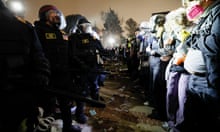
Protests continue at university campuses across US – in pictures

Thursday briefing: How Gaza protests have gripped American universities

Campus protests: UCLA students in standoff with police as demonstrations spread across US

Columbia University faculty ‘horrified’ by mass arrests of student protesters
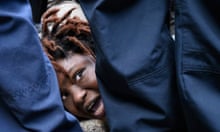
‘I was lying on the ground beside a wall of cops’: student photographers’ best images of the campus protests

Where are the US college campus protests and what is happening?
Most viewed.

IMAGES
VIDEO
COMMENTS
Conclusion: Mastering the Craft of School Report Writing in Secondary Education. The process of school report writing, especially in the context of secondary education, embodies more than just an administrative or assessment task; it's an art form that bridges the gap between a student's efforts and their achievements. Despite being time ...
Report writing is a key skill that is required in higher education and in the workplace. This brief, easy-to-follow video takes you through the key elements of writing a professional report and looks at what each of the sections of the report should include. Open this video in a new tab . and is part of the University Ready hub.
Writing plays a critical role in the growth of your educational ideas, helping you both deepen your understandings about the complex events that take place in schools and classrooms and share your observations and ideas with others. Writing in education classes serves a wide variety of specific purposes, depending on the audience, the author ...
The audience of a report is often someone in charge, for example a teacher, or an employer, so the language and tone of a report tends to be more formal. Tips for writing a report . Language - think about: • the audience that the report is for - are you writing this report for one reader, or for a group of people such as the organisers of ...
Investigation Skills and Report Writing for Higher Education focuses on improving interviewing techniques and post-interview tasks such as credibility assessment, information synthesis, and clear report writing. Participants will review a sample investigation report to guide their understanding of report writing mechanics, format, and structure ...
How to Write an Academic Report - Examples and Tips. Writing a report should be concise and to the point. It should also be relevant to the topic. Make sure to check your work with someone and read it aloud. Proofreading is also important because computer programs cannot catch every mistake. You may even want to wait a day before you read it ...
Report writing is common in a number of disciplines. A report is a specific form of writing, written concisely and clearly and typically organised around identifying and examining issues, events, or findings from a research investigation.Reports often involve investigating and analysing a problem and coming up with a solution. This means that you need to take a position or provide a solution ...
Essay and report writing skills Introduction. Most academic courses will require you to write assignments or reports, and this free OpenLearn course, Essay and report writing skills, is designed to help you to develop the skills you need to write effectively for academic purposes.It contains clear instruction and a range of activities to help you to understand what is required, and to plan ...
Organisation. Identify and group the key information, facts and details your report needs to include before you start writing - the structure of a report is usually in three parts. For example: An overview - briefly introduce the topic of the report and the key areas you will consider. Your reader should be able to understand what you will ...
The National Assessment of Educational Progress (NAEP) writing assessment measures how well America's students can write—one of the most important skills that students acquire and develop during K-12 schooling. Since 2011, students participating in NAEP writing assessments have been required to compose and type their responses on a digital ...
Report Writing Format for Class 10th to 12th. The report writing structure for students in grades 10 and 12 is as follows. Heading : A title that expresses the contents of the report in a descriptive manner. Byline: The name of the person who is responsible for drafting the report. It's usually included in the query.
Leave your report for a day or so and then return to it with fresh eyes. Correct any typing or grammar mistakes. If you have concerns, ask a colleague with good editing skills to review your report. Step 7. Attach any relevant information, such as technical reports on facilities or conference programs that supports your educational report.
How to Write an Academic Report. 1. Title Page. This means what it literally means. The title of the general report should be indicated on this page of the academic report. In some cases, the title page also includes your name as the author and student number, the name of the course and the course code. For example:
This is a Sample Format of a research Report Writing in Education mainly for M.Ed., M.A. (Education) and Ph.D. Scholars will be benefitted by this sample researched well before making.
Given the chance to rewrite what you already know of what a teacher report is, you would of course take the opportunity and revise what you used to know and apply what you already know. Come take a look at these five simple ways to write a teacher report. 1. Use Simple but Clear Jargon.
practical guidelines for writing a professional report, as well as the most common compenents of professional reports in special education. The When writing a report, always write it in the "Third Person." Reports are never written in the first person. A professional report will never use the word "I". Phrases that can be used include: •
Elements/What to Include in a Report Writing. 1. Title Page: Includes the report's title, the author's name, date, and other relevant information. 2. Abstract or Executive Summary: A concise overview summarizing the main points, findings, objectives, and conclusions of the report. 3.
recent years. In this report, we at 826 National aim to bring writing education to the forefront of public, policy, and funding conversations by examining its current state and issuing a call to action to the field. In the summer and fall of 2020, we interviewed 19 writing education experts, including authors,
Example 1. An educational tour is an excellent opportunity for students to learn outside of the classroom setting. It provides a chance for them to experience different cultures, explore new places, and gain practical knowledge that they can apply in real-life situations. The main purpose of this tour is to broaden the students' horizons and ...
teachers were spending on writing. In our initial report, writing education experts identified lack of time and the deprioritizing of writing as perhaps the biggest challenge to writing education. IES recommends that a kinder-gartener writes a minimum of 30 minutes a day and by 1st grade, a minimum
Advertisement In this article you are going to learn how to write a report on Educational Tour organize by your school. So with out much delay let's jump in. Example 1 Educational Tour From School By Ashlyn Tony Advertisement February 23, 2018; Karnataka: A bright morning, our tutor came in and announced we are going… Read More »
According to the commonly known definition of report writing, a report is a formal document that elaborates on a topic using facts, charts, and graphs to support its arguments and findings. Any report—whether it's about a business event or one that describes the processes of various departments in a company—is meant for a particular type ...
A new tool called Writable, which uses ChatGPT to help grade student writing assignments, is being offered widely to teachers in grades 3-12.. Why it matters: Teachers have quietly used ChatGPT to grade papers since it first came out — but now schools are sanctioning and encouraging its use. Driving the news: Writable, which is billed as a time-saving tool for teachers, was purchased last ...
Sweltering heat in the Philippines can curb farm production, disrupt water and power and weigh on businesses, but it also takes a toll on students, hampering the Southeast Asian nation's efforts ...
JACKSON, Miss. (AP) — Mississippi's Republican-led Legislature completed a last-ditch effort Thursday to revive a bill to regulate transgender people's use of bathrooms, locker rooms and dormitories in public education buildings.. Lawmakers pushed the proposal through the House and Senate in the final days of their four-month session after negotiations between the chambers broke down ...
Incident, which did not result in injuries, under review, while in California students and faculty condemn police crackdown at UCLA. This blog is now closed.